Inside: Check out 27 lake landscaping ideas to make your waterfront property even better and turn it into a peaceful outdoor spot you’ll actually want to use all year.
These tips help you enjoy your lake views and get more out of your natural surroundings.
If you own a lakefront property or a cabin, you already know the setting is pretty special. This list gives you practical and creative ways to improve your landscape while still blending with nature and protecting the shoreline.
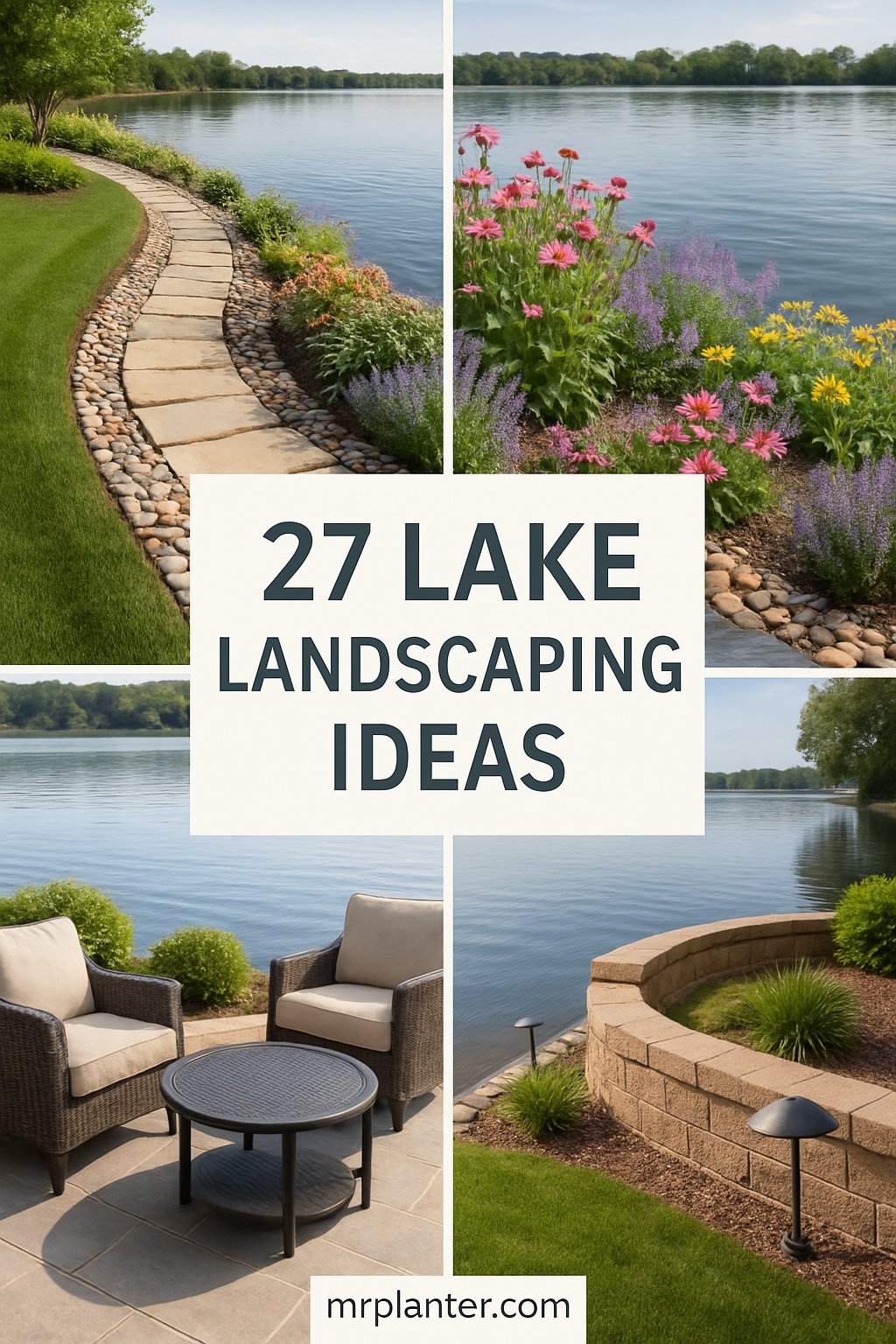
You’ll find ideas from simple plant choices to bigger structural features. These can help you design a space that actually feels like a lakeside retreat, not just another backyard.
1. Create a native plant garden with local wildflowers
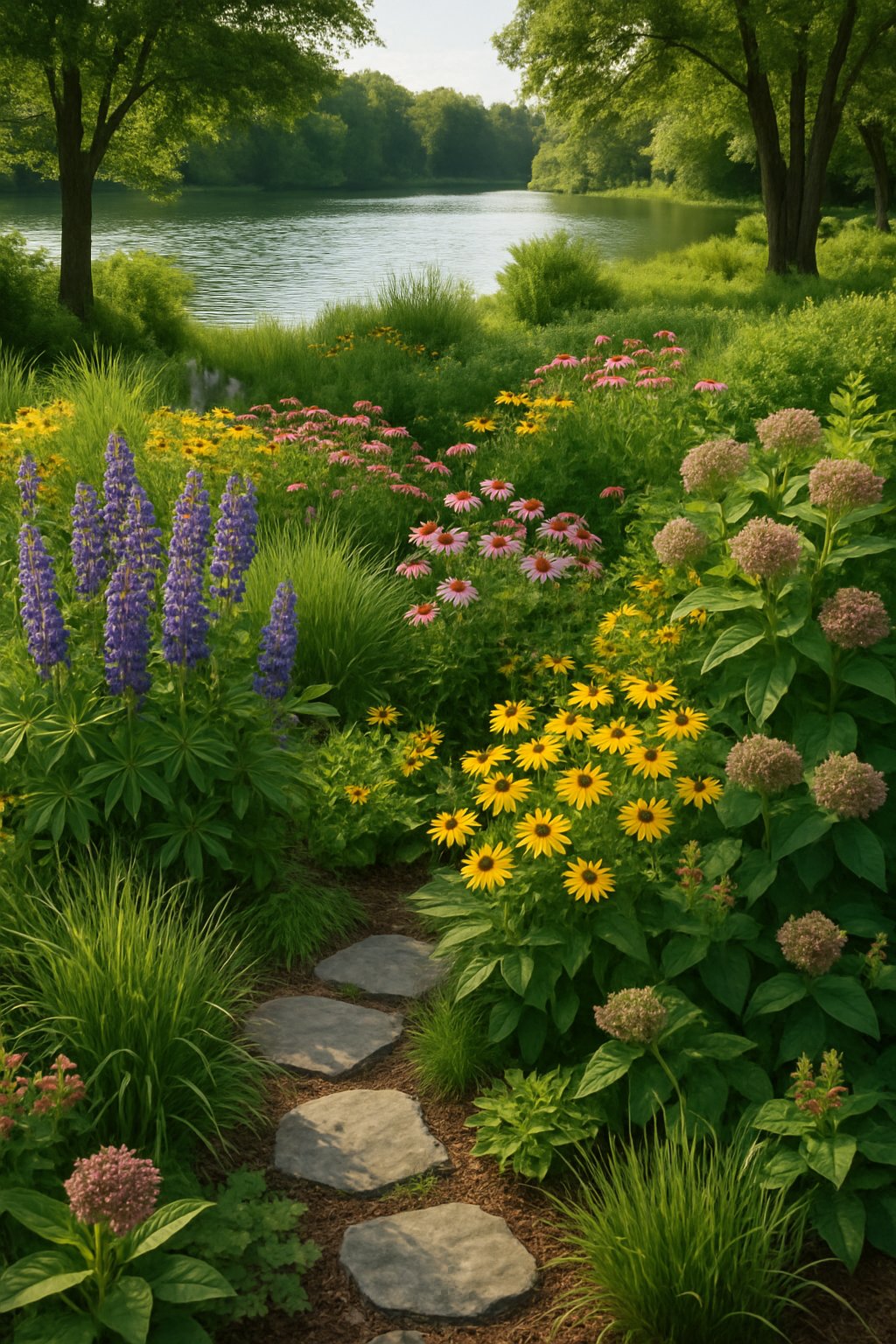
Start by picking wildflowers that grow naturally in your area. Native plants need less water and attention since they already thrive in your local soil and weather.
That means your garden will be easier to take care of. Native wildflowers bring in bees, butterflies, and birds, which helps support the local ecosystem around your lake.
Your garden will look vibrant and colorful, and you won’t have to work so hard to keep it that way. Planting native flowers also stops erosion along the lake’s edge.
Their roots hold the soil in place much better than most non-native plants, so your shoreline stays healthy and stable. Mix up different wildflowers for a more varied look.
Pick plants that bloom at different times, so you get color all season. Native plants just fit in better with the lakeside vibe.
Expert Tip from MrPlanter: “Start small and add more native flowers each year. That way, your garden expands naturally and never feels overwhelming.”
2. Build a multi-level deck overlooking the lake
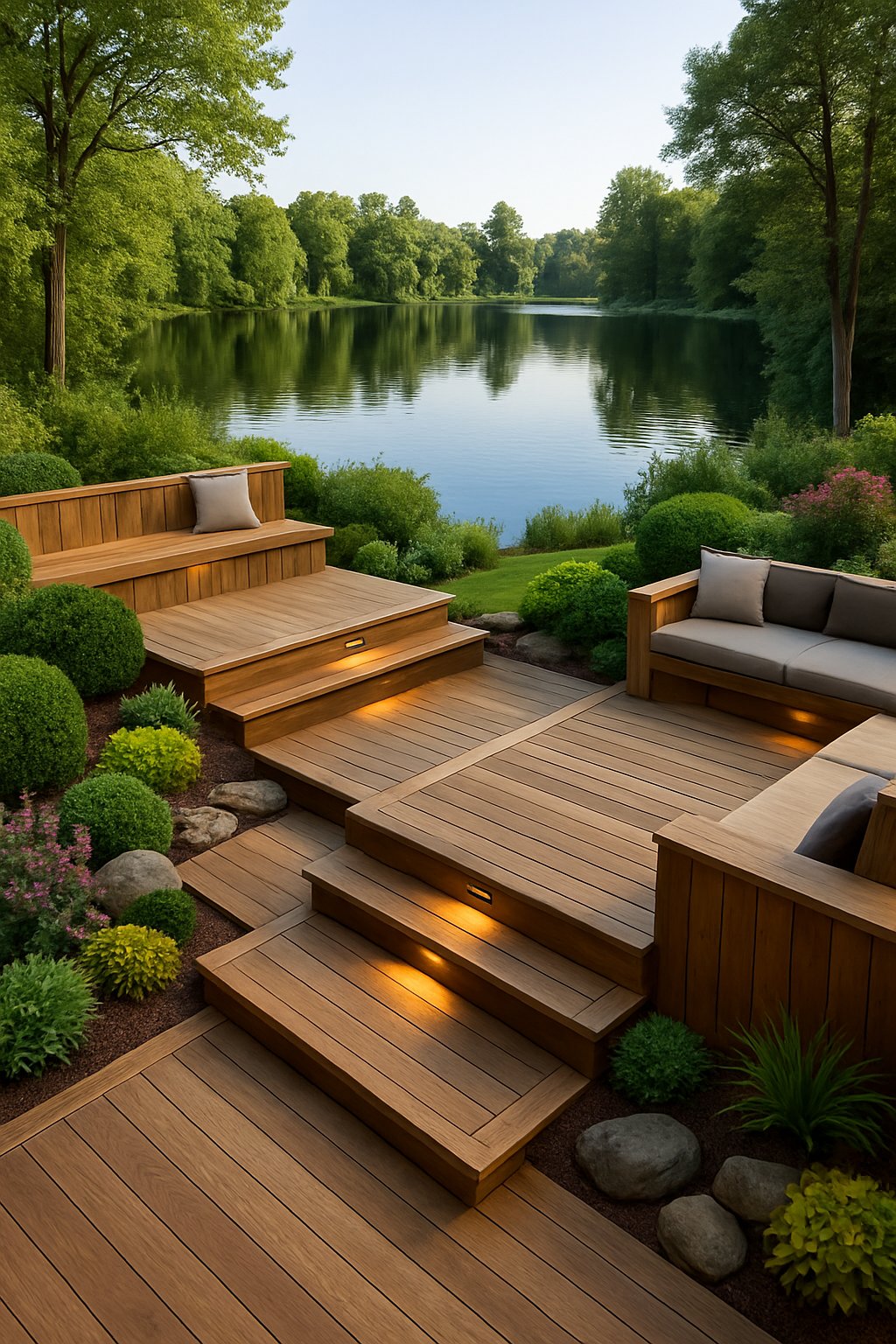
A multi-level deck gives you a bunch of different spots to take in the lake view. You might have one area for eating, another for relaxing, and maybe a quiet nook for reading or just watching the water.
Adding different levels means you get better views, too. When you build higher platforms, you don’t have to worry about anything blocking your sightline to the lake.
Multi-level decks let you spread out your activities without using up the whole yard. Everything stays connected, but you get more space.
Use tough, weather-resistant materials so your deck can handle lake air and moisture. Make sure it’s safe and easy to walk around.
Railings that don’t block the view—or even open sections—help you feel closer to nature. Honestly, it’s worth thinking about.
Expert Tip from MrPlanter: “Design each deck level for a specific purpose to get the most out of it. Stick with natural colors and materials so your deck fits right in with the lakeside scene.”
3. Install an elevated infinity edge pool

An elevated infinity edge pool gives your lake landscape a modern, luxurious feel. You get that smooth water line that looks like it just disappears into the horizon, making your lake view even more dramatic.
Builders usually put these pools above ground, so you can highlight your backyard’s natural features. You get all the style of an infinity pool without digging up your whole yard.
Just remember, elevated pools cost more than regular ones, and you’ll need solid support and good drainage to avoid water problems. You might want to add features like waterfalls or lighting to make the pool area stand out.
These touches help the pool blend in with your lake’s natural beauty. You’ll need to keep up with maintenance to keep the infinity edge looking sharp.
Regular cleaning stops buildup that can ruin the effect. An elevated infinity edge pool really boosts your home’s outdoor appeal.
If your lake view is the main event, this is the way to go.
Expert Tip from MrPlanter: “Position your pool so the infinity edge lines up with the lake’s horizon for a seamless water look. Use natural stone around the pool to tie it into the landscape.”
4. Add a cozy fire pit area with Adirondack chairs
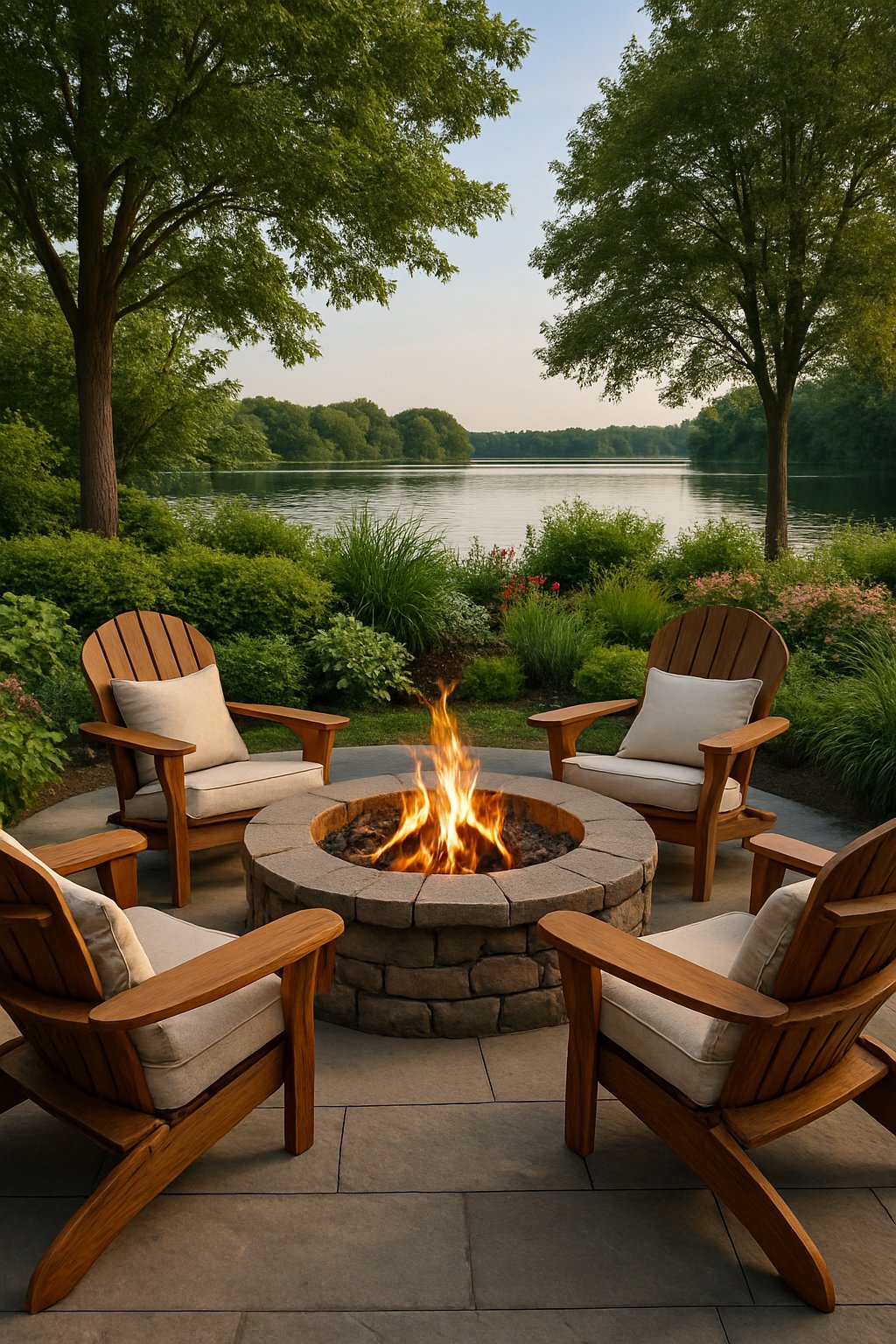
A fire pit gives you a warm gathering spot by the lake, especially when the evenings get chilly. Adirondack chairs just work—they’re comfy, classic, and fit right in with the outdoors.
Pick a fire pit that matches your style. Wood-burning ones feel natural and smell great, but gas fire pits are super convenient and easy to control.
Arrange your Adirondack chairs in a circle around the fire pit for cozy chats and shared warmth. Toss on some cushions or blankets to make the space even more inviting on cold nights.
Use stone or wood for the fire pit area so it blends in with the lakeside. You’ll want the whole setup to feel like it belongs there.
Expert Tip from MrPlanter: “Put your fire pit downwind from the seating so smoke doesn’t blow in your face. Go for weather-resistant cushions so your chairs stay comfy all year.”
5. Use ornamental grasses as natural shoreline buffers
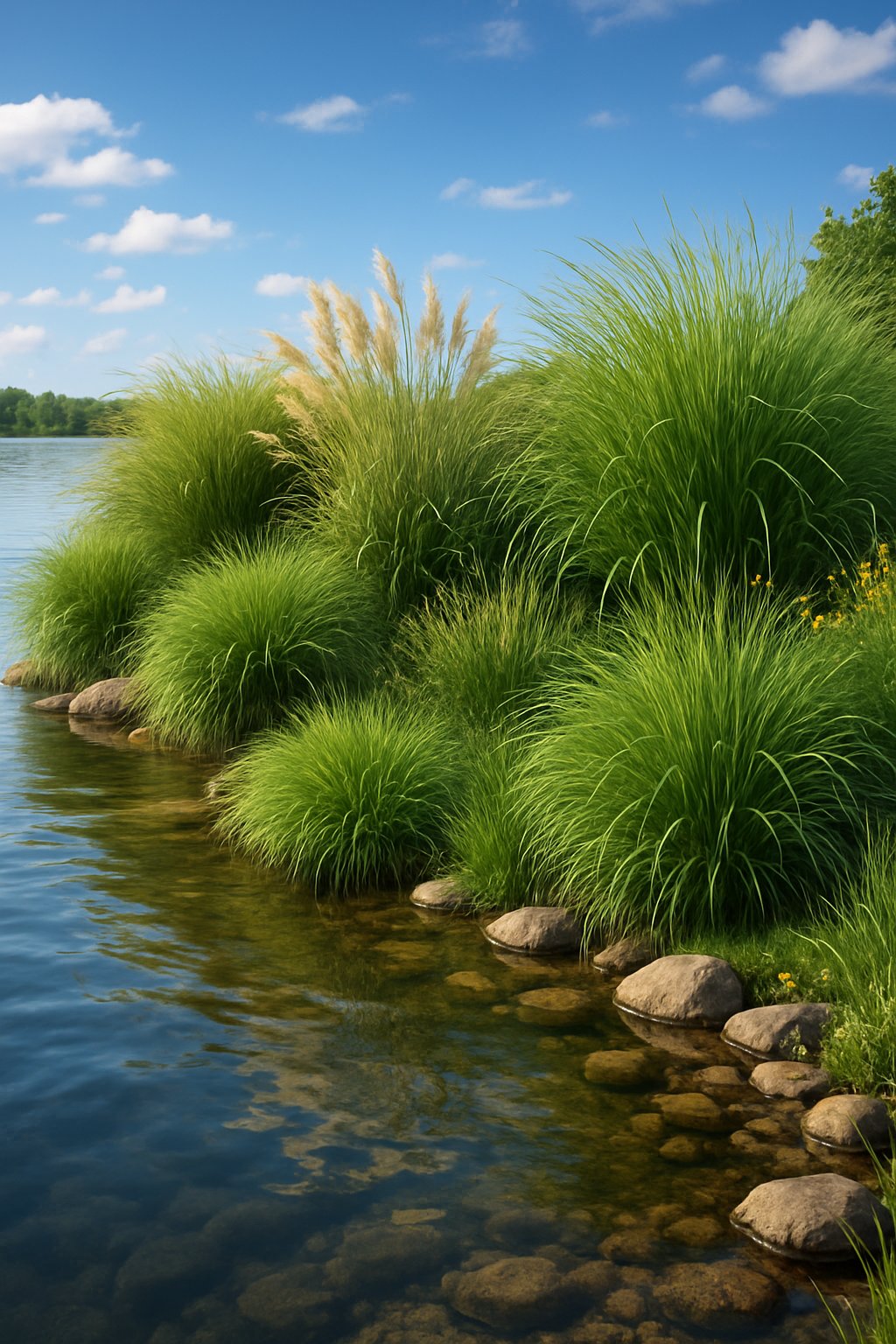
Ornamental grasses make great natural buffers along your lake’s edge. They slow down runoff, stop soil erosion, and help keep the water clean.
These grasses also soften the look of your shoreline and blend in with the natural setting. Pick a mix of heights and textures for more depth and visual interest.
They’ll attract birds and butterflies, so your shoreline feels more alive. Once they’re established, you don’t have to do much maintenance.
Plant grasses in clusters for better stability and to cut down on sediment washing into the lake. Their roots grip the soil and protect the shore from waves and rain.
Expert Tip from MrPlanter: “Choose native grasses so you won’t have to water as much. Mix tall and short types for privacy and a look that changes with the seasons.”
6. Plant low-growing shrubs to frame the lake view
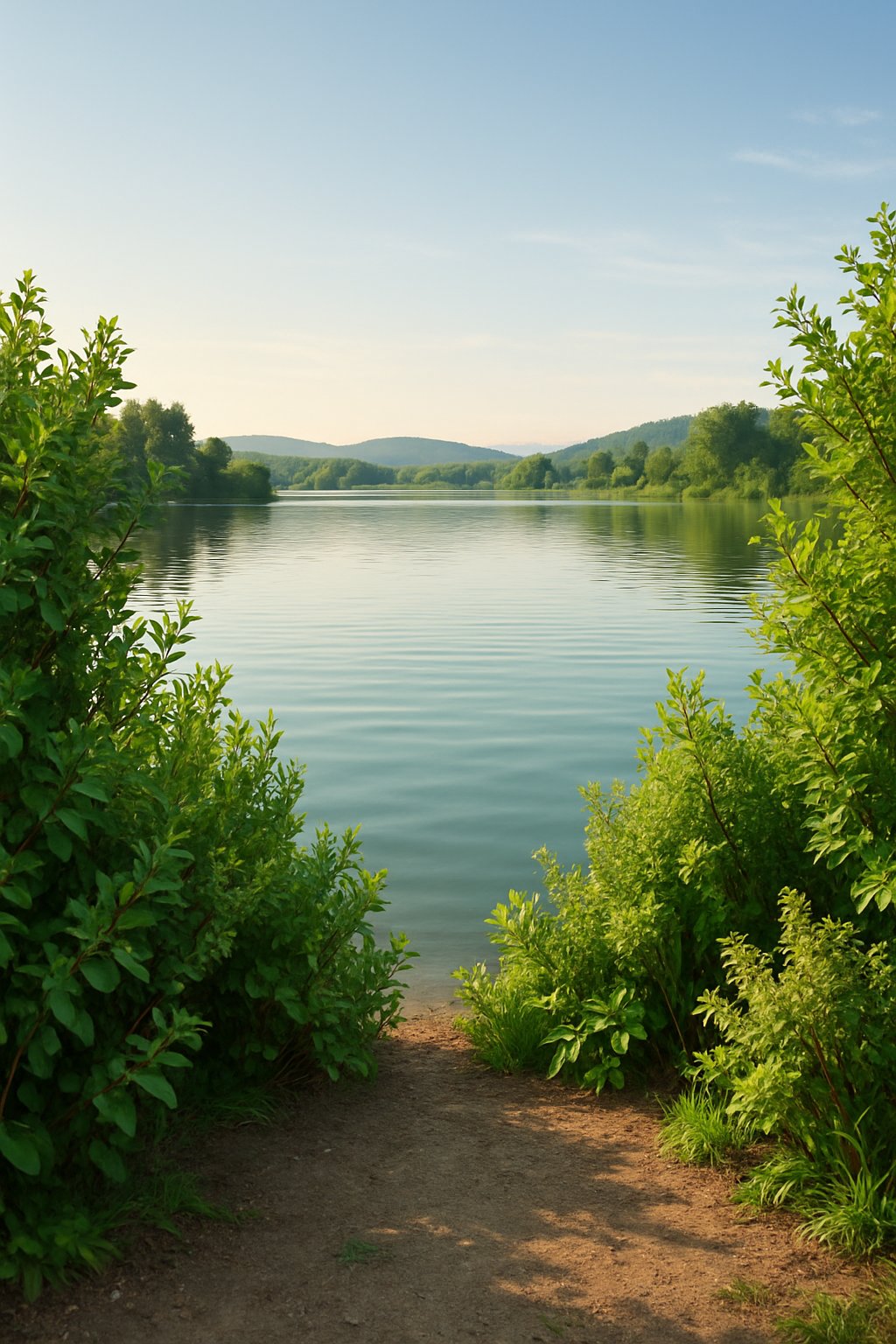
Planting low-growing shrubs near the shore helps you highlight the lake without blocking your view. Go for shrubs that stay under four feet, so you can enjoy the water and still get color and texture.
Mix evergreen and flowering shrubs to keep things interesting year-round. Low shrubs make a soft border between your yard and the lake.
Put taller plants or small trees behind the shrubs to frame the scene without taking over. This layered approach makes your lakefront feel balanced and welcoming.
Pick easy-care plants that fit your climate. That way, your landscaping stays pretty without much effort.
Expert Tip from MrPlanter: “Go with native shrubs that match your local conditions for less hassle. Cluster plants together to create natural frames around your favorite views.”
7. Incorporate perennial flowers for season-long color
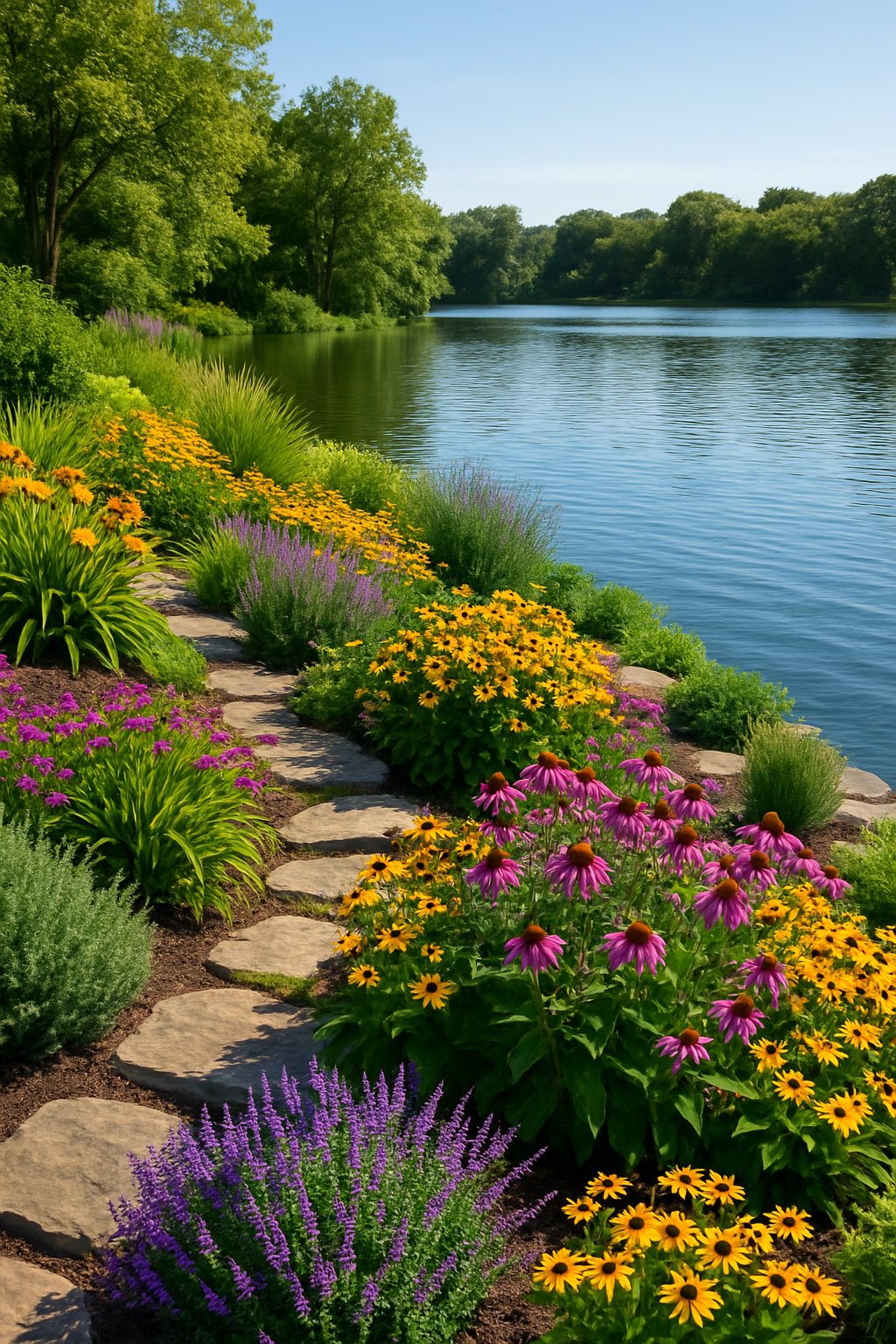
Adding perennial flowers keeps your lake landscape colorful all season. Pick plants that bloom at different times so there’s always something going on.
Look for perennials with cool leaves—like speckled or variegated ones—so you get color even when they’re not blooming. Mixing heights and textures adds depth to your garden.
Try combinations like sedum and ajuga for steady interest from spring to fall. Perennials attract pollinators, so your garden stays lively.
Think about how much sun your garden gets and pick plants that will actually thrive there. That way, your perennials stay healthy and look good all season.
Expert Tip from MrPlanter: “Start with easy-care perennials to build your confidence. Group plants with similar water and light needs for the best results.”
8. Design a gravel pathway leading to the water
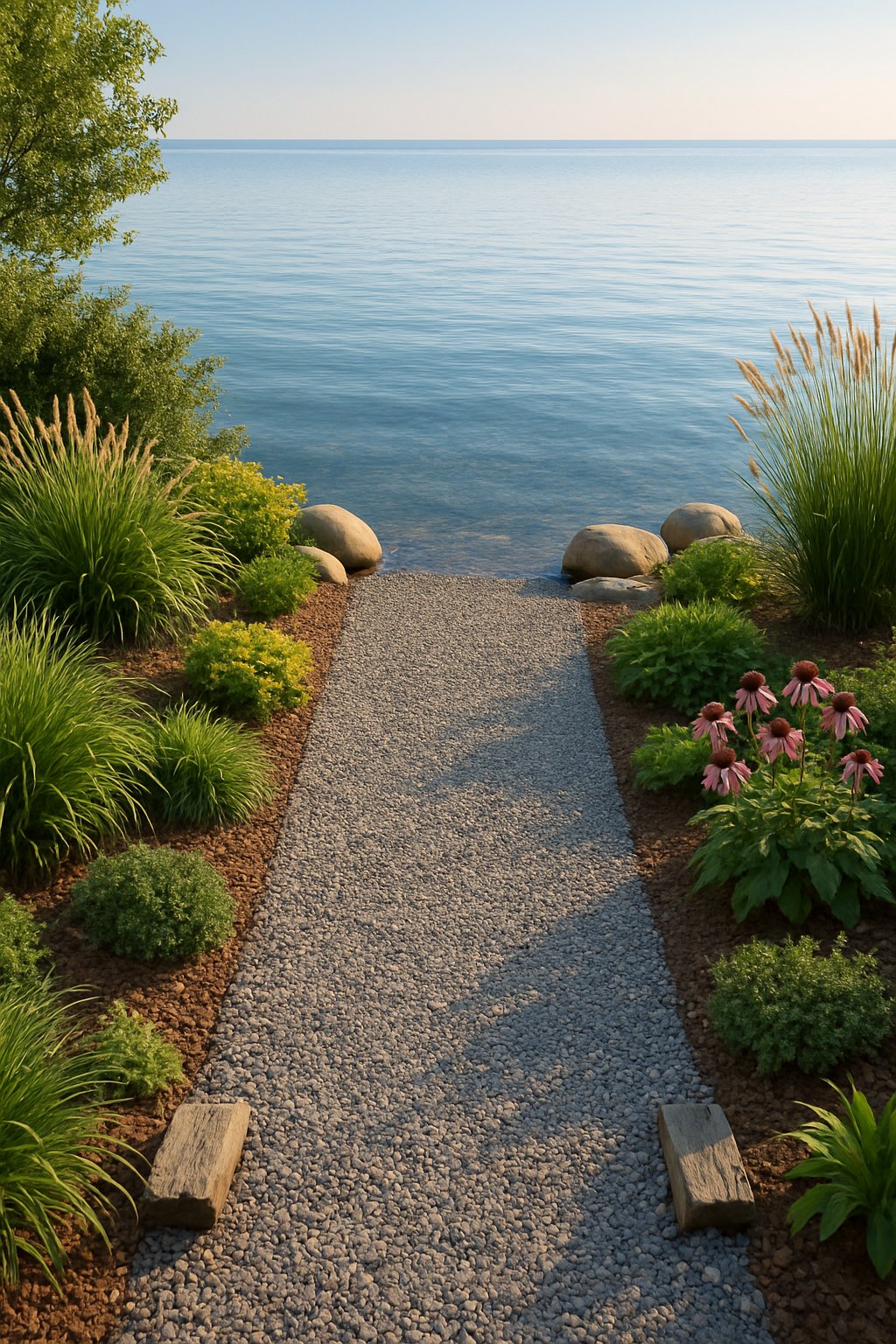
A gravel pathway is a simple, natural way to guide people from your yard down to the lake. It fits the outdoorsy feel and keeps things looking neat.
Use bricks or stones as borders to keep the gravel in place and add a little style. Gravel paths are easy to put in and don’t need much maintenance.
Pick small, smooth gravel so it’s comfortable to walk on. You can add stepping stones if you want a bit more charm and stability.
Plant some low-maintenance bushes or succulents along the edges to frame the path. This helps your pathway feel like it belongs in the landscape.
Gravel also helps with drainage, so you won’t get puddles after it rains. Your path stays safe and clean all year.
Expert Tip from MrPlanter: “Lay landscape fabric under the gravel to keep weeds out but let water drain. It keeps your path tidy for longer with less effort.”
9. Install a stone fireplace for outdoor gatherings
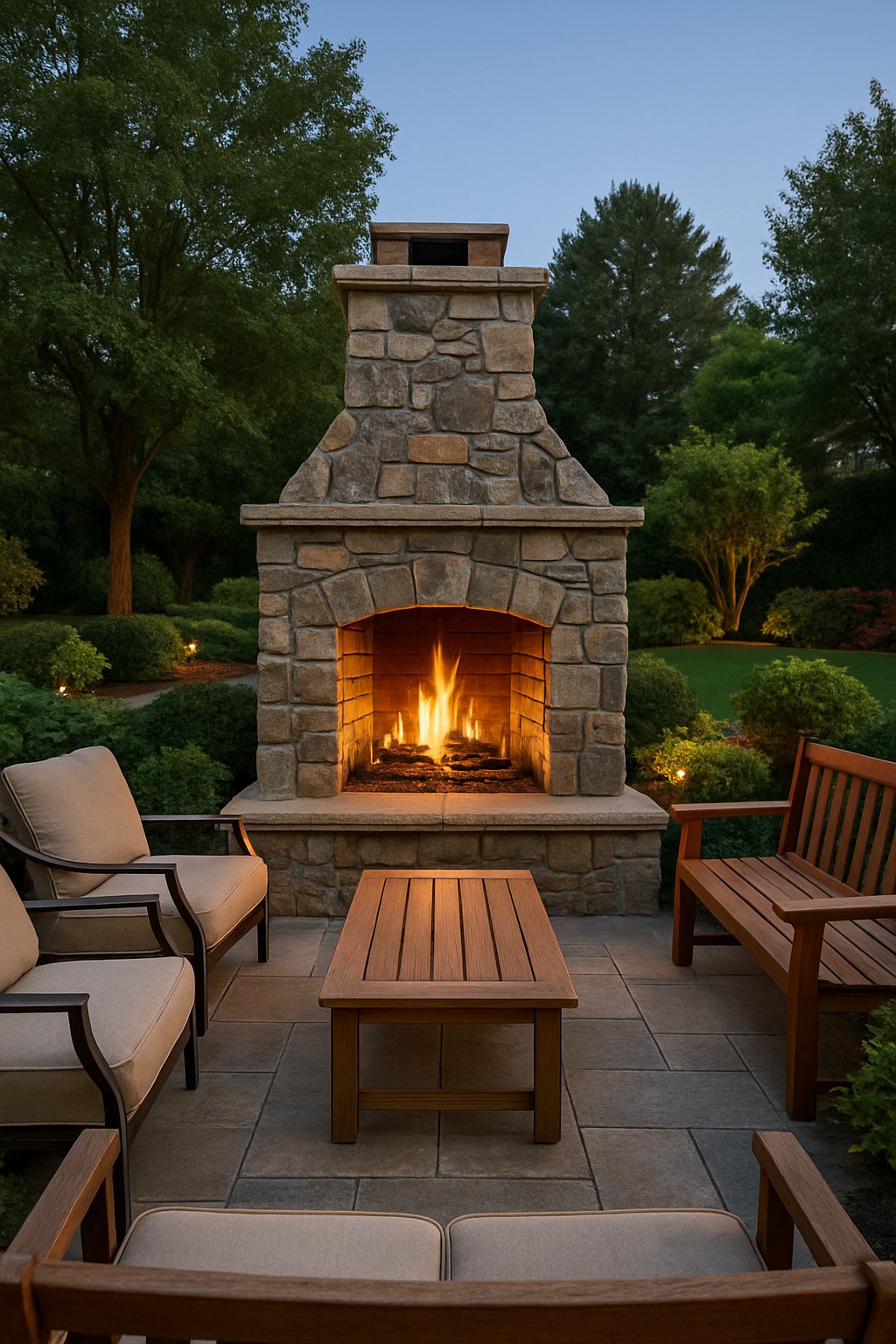
Add a stone fireplace near your lake so you have a cozy spot to hang out with friends and family. It gives you both light and warmth, making chilly evenings way better.
Stone fireplaces fit in with the natural surroundings, whether you want a rustic stacked stone look or something more modern. Place the fireplace where everyone can reach it, but don’t block the lake view.
A deck or patio works great for this. Stone fireplaces also boost your property’s value and make your outdoor space more useful.
You can use real wood or gas for the fire. Gas is easier to manage and quick to start.
Set up some benches or chairs around the fireplace to invite people to stay and enjoy. Lighting, like string lights or lanterns, adds to the cozy vibe.
Expert Tip from MrPlanter: “Pick heat-resistant stone that holds up outdoors. Plan your seating and paths to keep everything safe and comfortable.”
10. Add floating gardens for a unique water feature
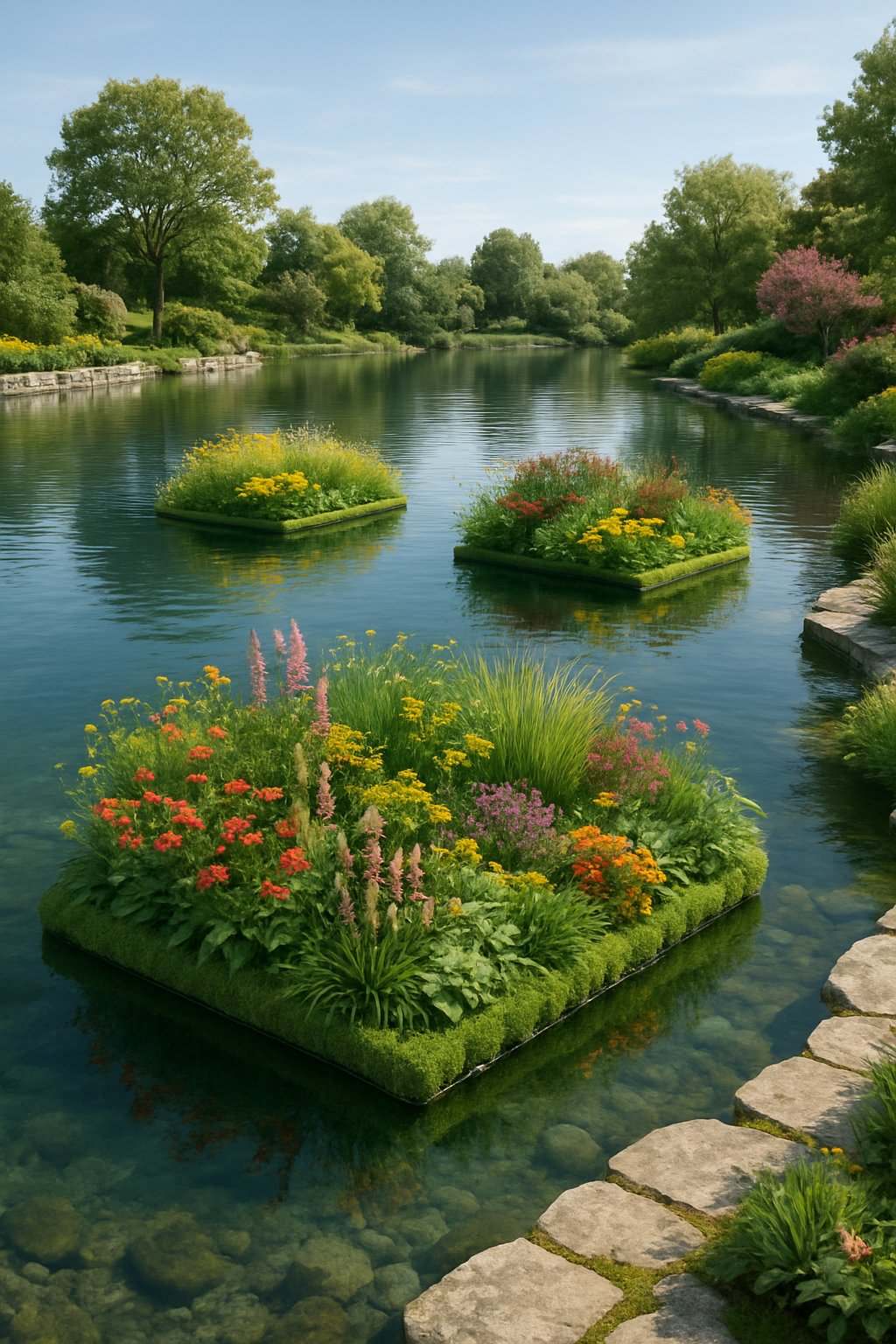
Floating gardens bring life and color right onto your lake. They sit right on the water and hold all kinds of plants—flowers, even aquatic ones.
When the wind blows, these gardens drift gently, making the water look even more peaceful.
You can build a floating garden with a lightweight frame and fill it with soil. Anchor it so it doesn’t float away. The plants soak up nutrients and help keep algae in check, so the water stays clearer.
Birds and pollinators will show up before you know it, drawn in by the new blooms. If you want a natural look but don’t want to mess with the shoreline, floating gardens are a great choice.
Don’t worry about spending a fortune. Start simple—try easy-care plants like water lilies, irises, or hostas. You’ll get different colors and textures as the seasons change.
Expert Tip from MrPlanter: “Choose native plants for your floating garden to support local wildlife and reduce maintenance. Make sure your garden is securely anchored to avoid drifting into unwanted spots.”
11. Set up an outdoor dining patio with lake views
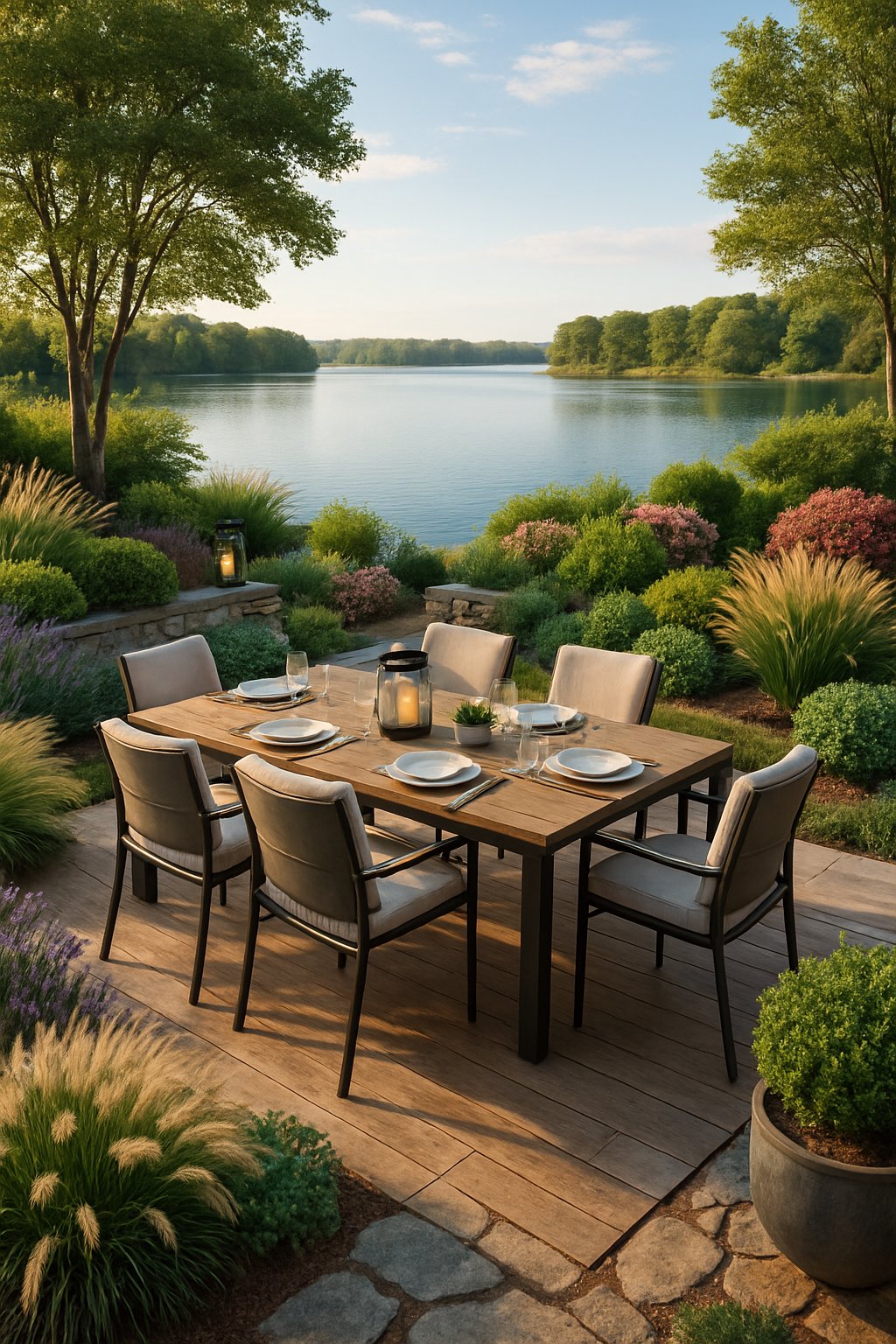
Imagine eating dinner while you watch the lake. Pick a spot with a good view and maybe a little shade for those hot afternoons.
A good location makes your outdoor dining feel extra special.
Pick sturdy furniture that fits your style and can handle the weather. A solid table and comfy chairs make gatherings better. Toss in some cushions if you want it cozier.
Think about bugs and too much sun. An umbrella or pergola works for shade, and citronella candles keep the insects at bay.
String lights or lanterns can turn evenings into something magical. Add a few plants nearby to make the whole space feel more relaxing.
Expert Tip from MrPlanter: “Place your dining area where you get morning sun and afternoon shade for the best comfort. Use weather-resistant materials to keep your patio looking good year-round.”
12. Create a layered planting scheme with small trees
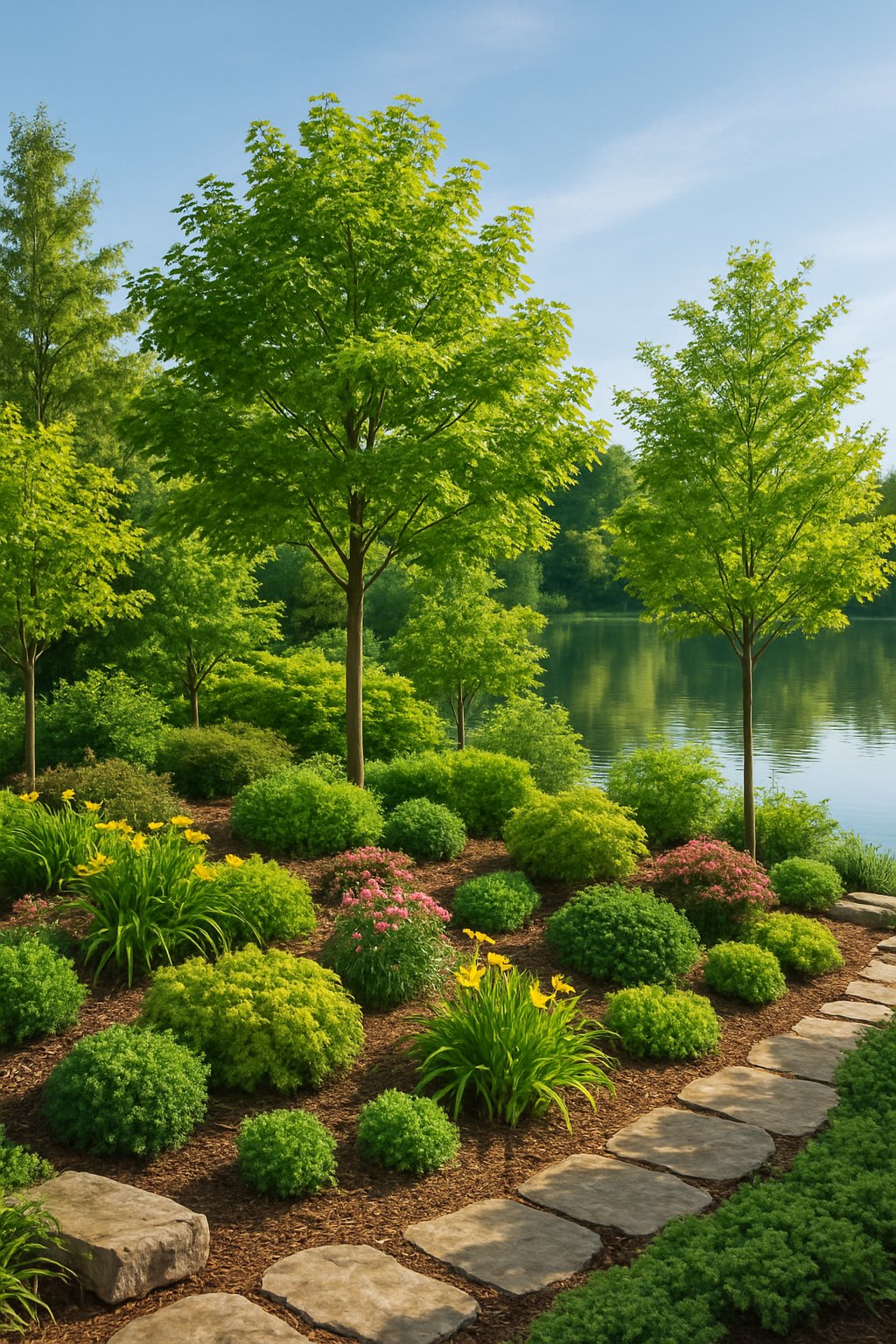
Use small trees to add height, but don’t block your lake view. Place them behind shorter plants like shrubs or flowers. That way, you get a nice flow from tall to short.
Pick trees that fit your space. Dwarf or slow-growing ones work great near water. They add structure but won’t take over the whole view.
Try mixing tree types for some variety. Flowering or ornamental trees bring in color and texture. Keep things balanced—space them out so it doesn’t look crowded.
Layering plants draws your eyes toward the lake. Put low perennials and grasses in front to soften the edges. Now your garden feels full, not jam-packed.
Expert Tip from MrPlanter: “Start with your tallest small trees first, then fill in with shorter plants. This keeps your layers neat and helps plants grow well together.”
13. Use retaining walls with natural stone
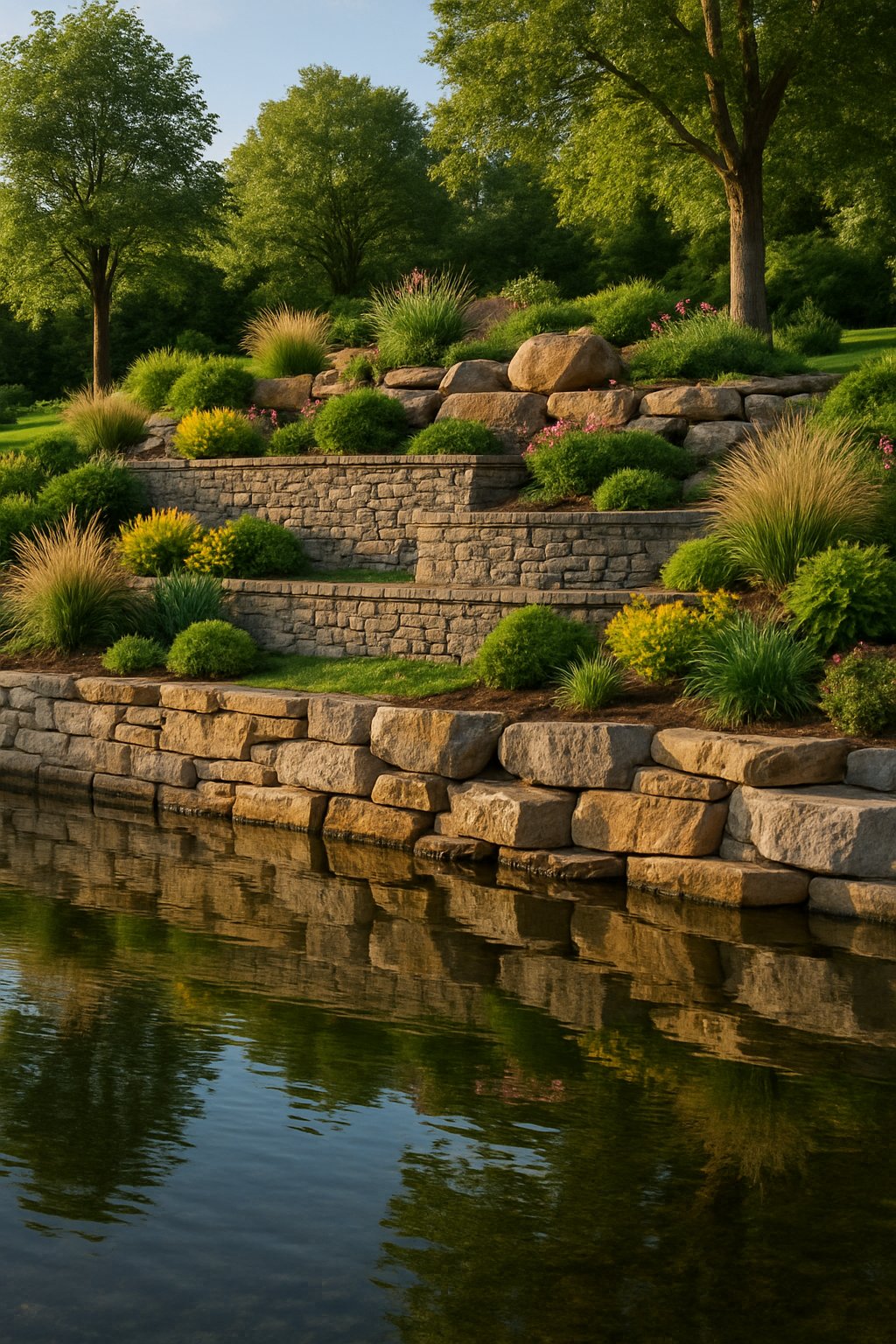
Stacking natural stone for retaining walls adds a tough, lasting barrier to your lakeside landscape. The stones blend right in and give you a clean divide between yard levels. That helps keep erosion under control.
You can stack the stones without mortar for a rustic look, or use mortar for extra strength. Dry-stacked walls work best if you keep them under four feet. They let water drain and lower the pressure on the wall.
Stone walls can double as seating or a spot for your favorite plants. Mixing large boulders with smaller stones adds texture and interest. It just makes the place feel timeless.
Expert Tip from MrPlanter: “Choose stones that match your natural surroundings to keep the look seamless. Always check drainage before building to avoid water pressure damage.”
14. Build a wooden pier or dock for easy water access
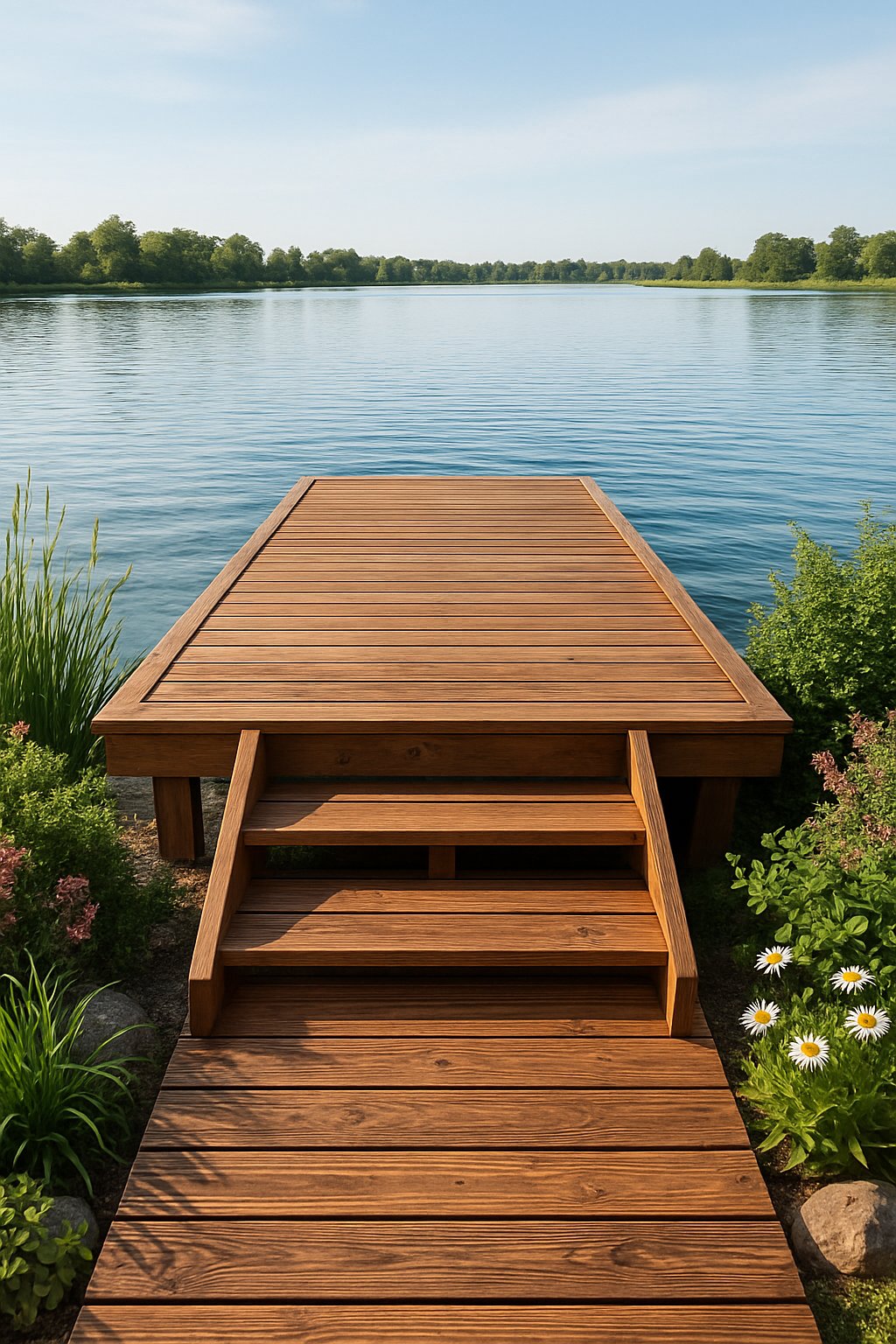
A wooden pier or dock makes it easy to hop in and out of the water. It gives you a sturdy spot for swimming, fishing, or just kicking back by the lake.
Pick from different dock styles. Floating docks go in quick and adjust if the water rises or falls. Fixed docks feel more solid and stick around longer.
Add built-in seating or a ladder for comfort and convenience. Treated wood keeps the dock safe from water and weather.
Make the dock wide enough so you can haul gear or invite friends. Plan it so the walkway stays dry and safe.
Expert Tip from MrPlanter: “Check your local rules before building a dock. Use durable wood and regularly maintain it to keep your dock safe and sturdy.”
15. Install solar landscape lights along walkways
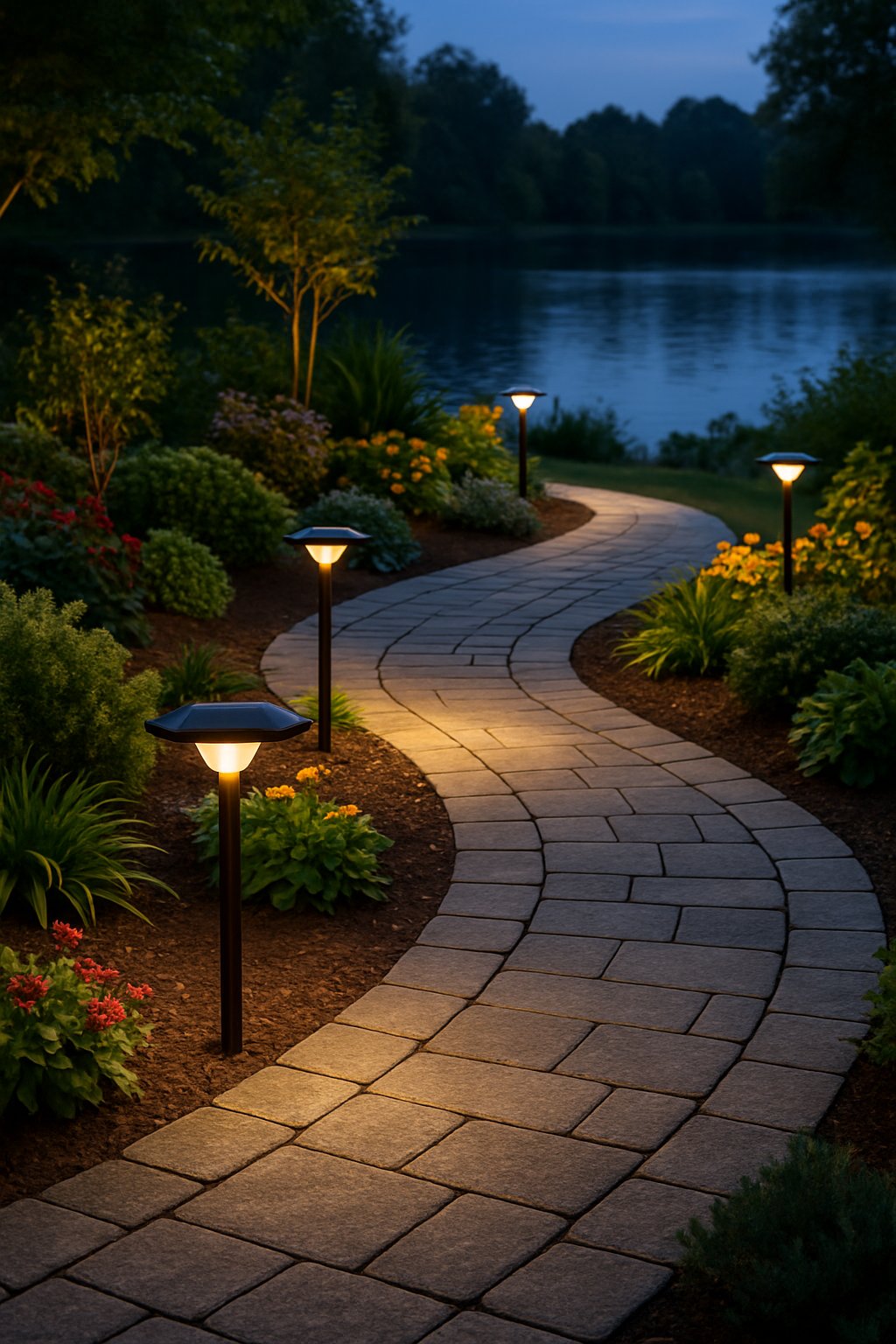
Line your walkways with solar lights to make your lake area safer and more welcoming. These lights soak up sun all day and switch on by themselves at night, so you don’t have to mess with wires.
Set them up along curved or straight paths to guide your way. Solar lights come in tons of styles, so just pick what fits your garden vibe.
They run on sunlight, so you save electricity and skip the tricky installation. Plus, they help everyone avoid tripping in the dark.
Go for lights that are bright enough, but not blinding. You want a warm glow, not a spotlight. Check that nothing blocks them—plants or trees can get in the way.
Expert Tip from MrPlanter: “Place solar lights in sunny spots to ensure full charging during the day. Group a few closely to brighten darker areas along the path efficiently.”
16. Plant shade trees near seating areas
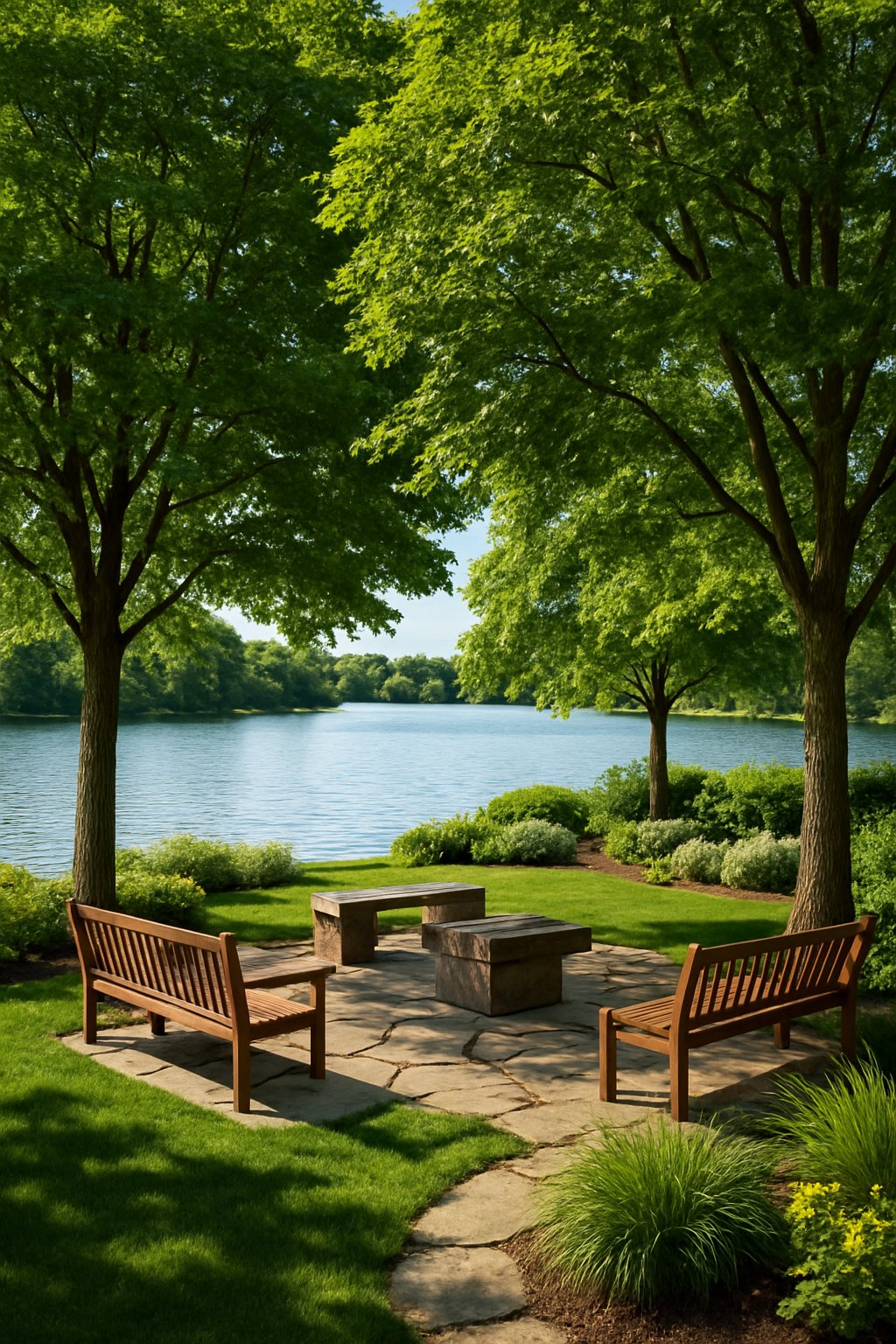
Shade trees by your seating areas make hot days a lot more comfortable. Maples, oaks, or birches work well—they give you natural shade and a chill spot by the lake.
Trees add beauty too, especially as their leaves change with the seasons. You can sit outside longer without getting roasted by the sun.
Set up benches or chairs under the tree canopy for a peaceful spot to watch the water. The shade helps protect your outdoor furniture from fading.
Pick trees that thrive in your climate and soil. Make sure they don’t block too much of the lake view, but still throw enough shade to keep you cool.
Expert Tip from MrPlanter: “Pick native shade trees for easier care and stronger growth. Space trees far enough apart so each one can spread fully and give good shade.”
17. Include a Zen rock garden near the shore
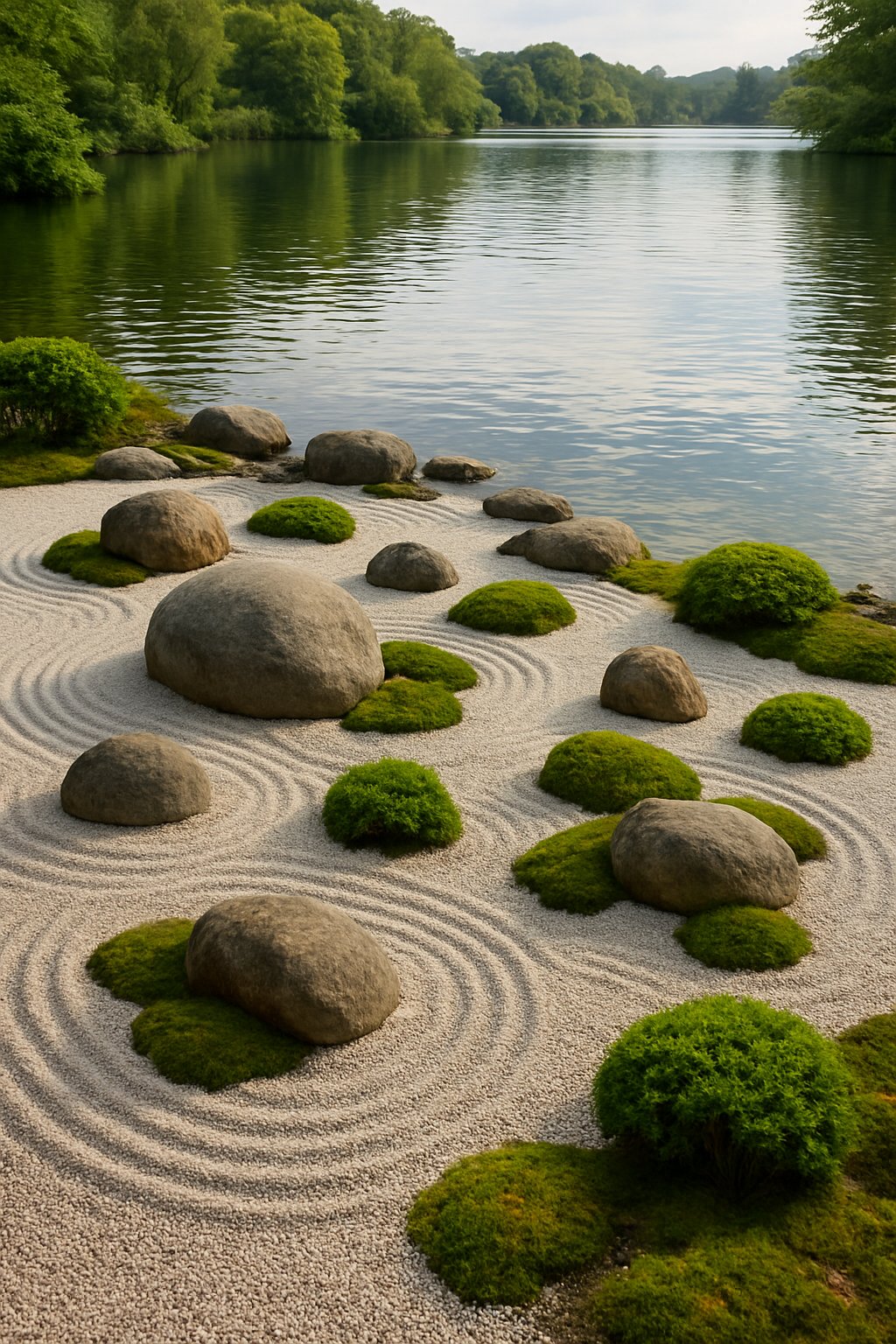
A Zen rock garden by the lake brings calm vibes. Use smooth stones and gravel to create patterns that look like ripples or waves. It’s a simple, low-maintenance way to add peace to your space.
Arrange rocks of different sizes in a balanced way. Surround them with fine sand or pebbles. Rake gentle lines or swirls—honestly, it’s kind of relaxing.
Add a few small plants, maybe moss or bamboo, for some extra green. Keep it tidy to hold onto that serene feeling. A Zen garden fits right in with lakeside views and gives you a quiet spot to unwind.
Expert Tip from MrPlanter: “Choose stones with varied shapes and colors for a natural look. Rake patterns regularly to keep the garden fresh and calming.”
18. Create a lawn-free zone with native groundcovers

Swap grass for native groundcovers and you’ll save water and time. These plants love your local climate and help wildlife thrive. They make a low-maintenance area near the lake that always looks natural.
Pick groundcovers that match your sun and shade. Silk tassel does well in the sun, while silver sedge prefers shade. They fight off soil erosion and keep things green all year.
Native groundcovers attract birds and pollinators, so your yard feels alive. Mix in wildflowers for a splash of color and a little extra charm. Most don’t need mowing, so you can relax more.
Expert Tip from MrPlanter: “Pick groundcovers that match your soil and water levels for best growth. Layering different plants adds texture and keeps your yard looking full.”
19. Add birdhouses and butterfly-friendly plants
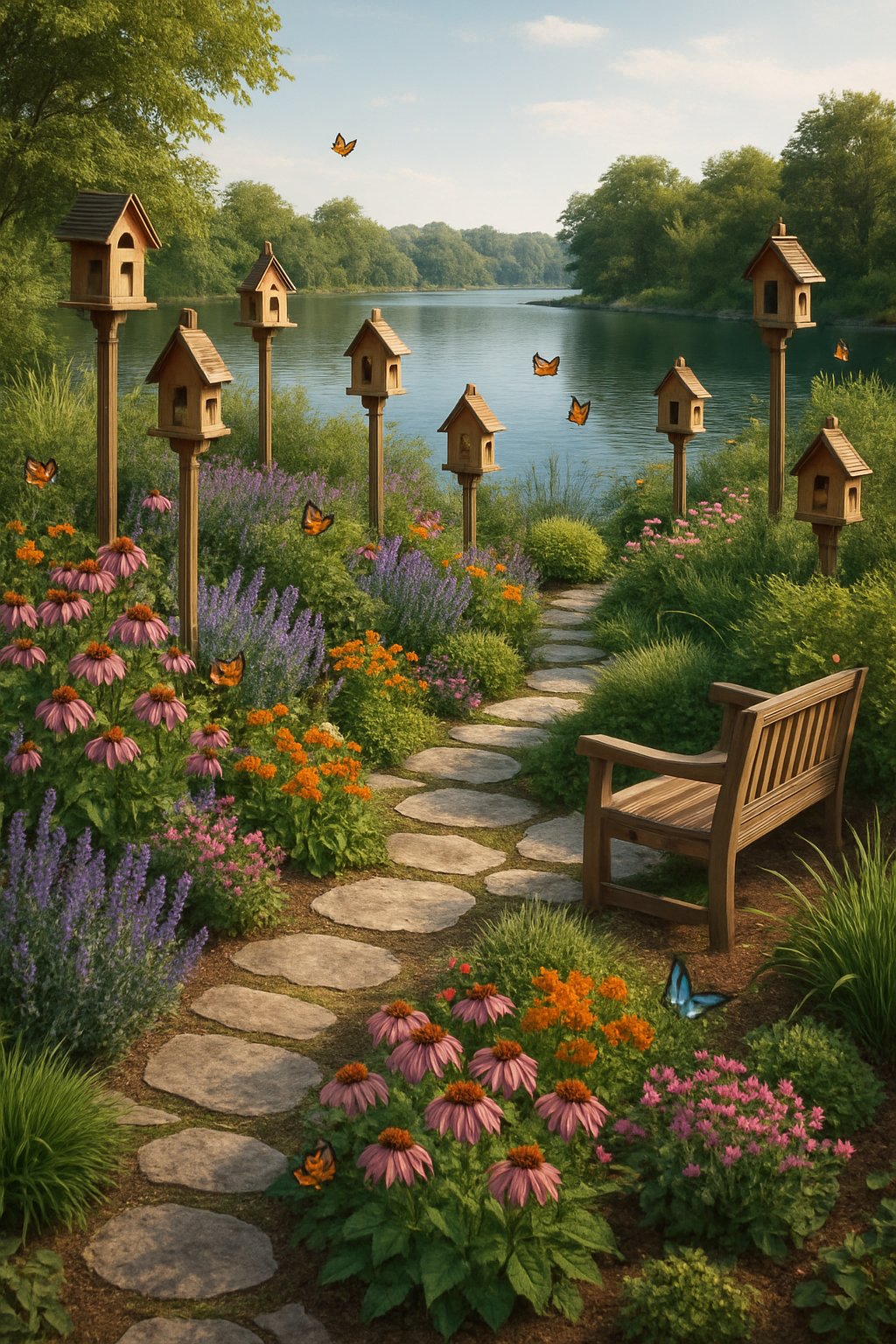
Put up birdhouses around your lake to invite feathered friends to visit and nest. Pick designs that match local birds and set them away from places predators can reach.
Plant butterfly favorites like milkweed, black-eyed Susans, and goldenrod. These flowers feed butterflies and other pollinators, and they look great too.
Add colorful, easy-care perennials near the water’s edge. You’ll create a natural habitat that’s both lovely and helpful for wildlife.
Set up shallow water spots so birds can drink and bathe. It keeps your garden lively and healthy.
Expert Tip from MrPlanter: “Place birdhouses at different heights to attract various birds. Use native plants for the best results with butterflies and pollinators.”
20. Use river rock in landscaping beds for texture
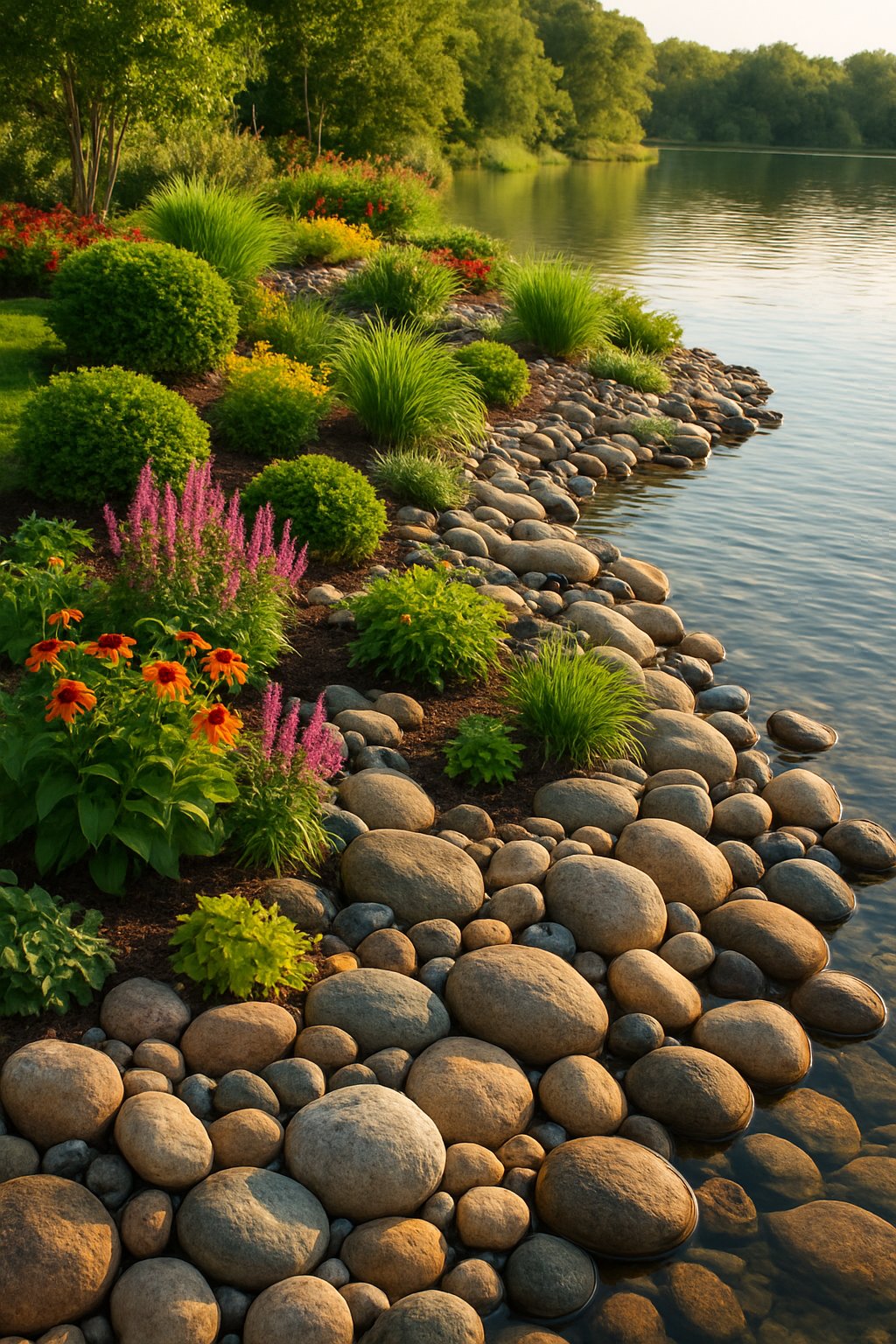
Scatter river rock in your landscaping beds for a natural, textured look. The smooth stones pop against plants and soil, so you don’t need a ton of different plants to make things interesting.
River rocks help keep soil erosion in check by holding mulch and dirt in place. Use them to outline flower beds or fill gaps between plants. Your garden stays neat and is way easier to maintain.
Pick river rocks that match your home or garden colors. Use a mix of sizes for depth and that “found in nature” style. The rocks last ages and won’t wash away when it rains.
Expert Tip from MrPlanter: “Place a weed barrier fabric under the rocks to reduce unwanted growth. This keeps your landscape bed looking clean longer.”
21. Install a small greenhouse for year-round plants
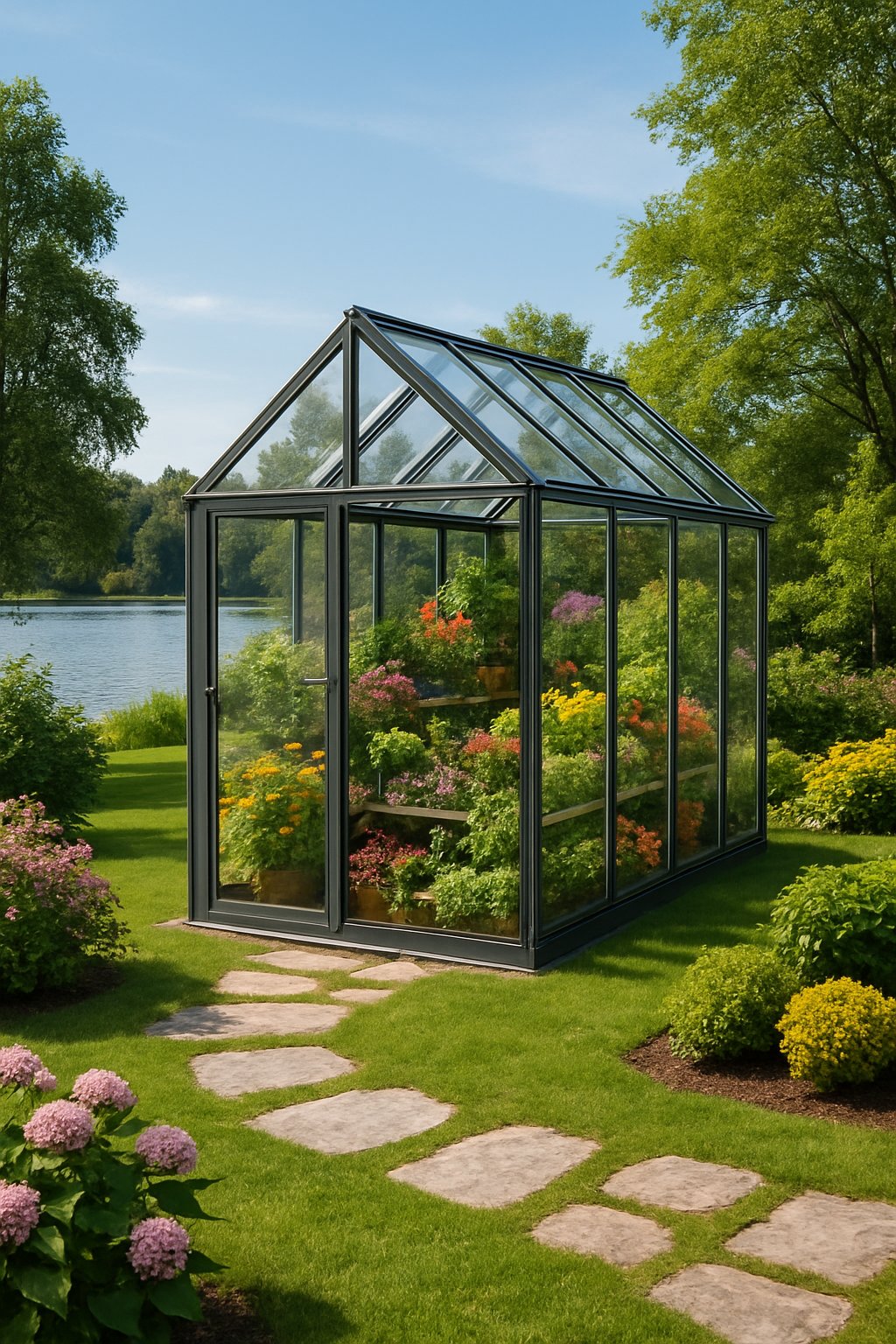
Try adding a small greenhouse near your lake—you’ll get to grow plants all year. It keeps your plants warm in the cold months and shields them from rough weather.
Grow vegetables, herbs, or even tropical plants that need a bit more care. A compact greenhouse doesn’t take up much space but can totally change your gardening game.
Put some shelves inside to give yourself extra room for plants. Just be sure to leave enough space so each plant can stretch out and thrive.
Use clear glass or acrylic for the walls so sunlight pours in. Try to set the greenhouse where it’ll catch the most sun—usually facing south works well.
If you live somewhere cold, bring in cold frames or move plants inside during winter. You’ll keep your garden green even when the weather gets nasty.
You can control the humidity inside, which is awesome for plants that love a little extra moisture in the air.
Expert Tip from MrPlanter: “Place your greenhouse near your main garden path for easy care access. Use energy-efficient materials to save on heating costs and keep plants healthy.”
22. Design a hammock spot with views of the lake
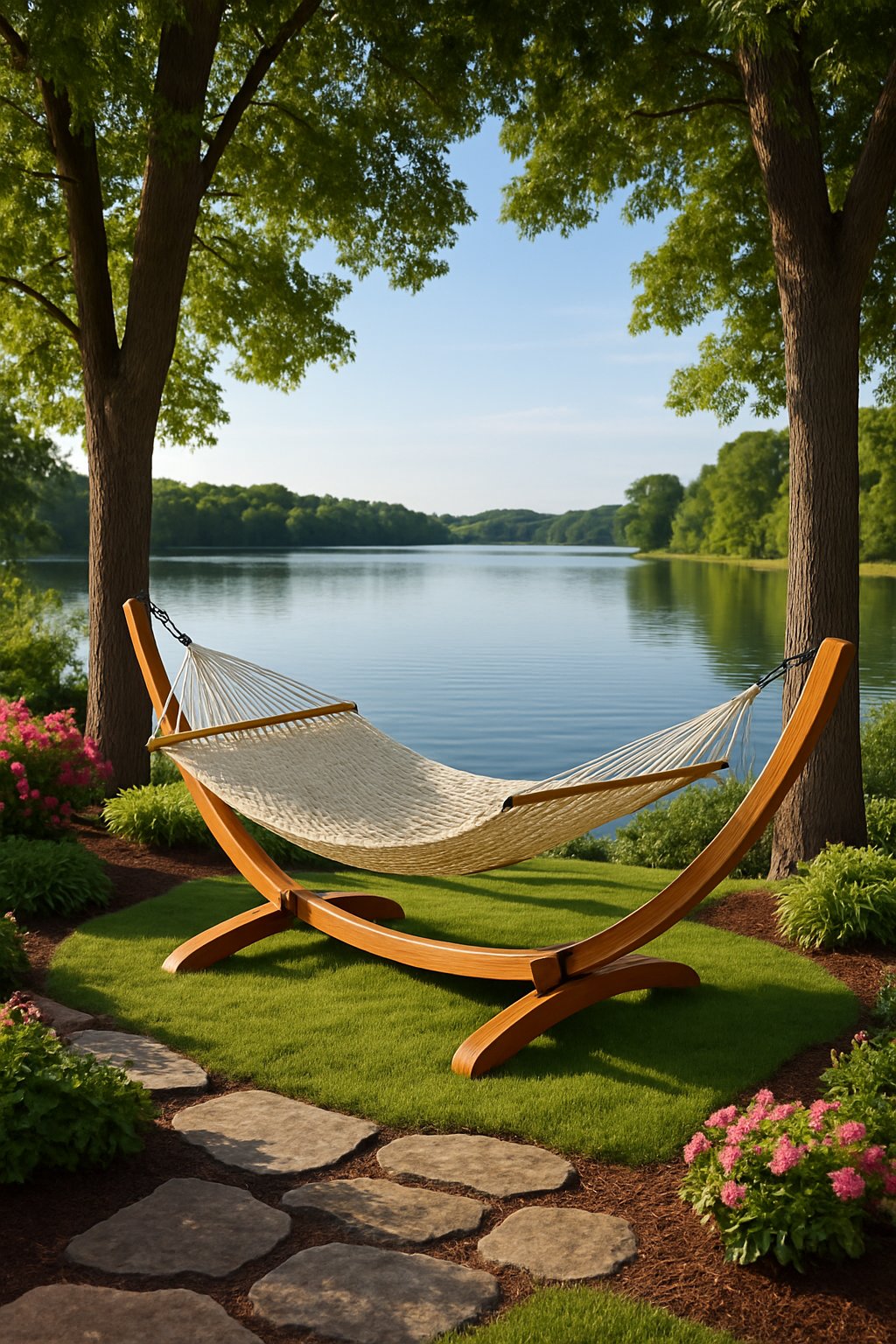
Set up a relaxing spot by hanging a hammock where you can really see the lake. Pick a quiet place with natural shade from trees to stay cool on hot days.
Check that the ground is level and solid for your hammock. That makes setup so much easier.
Add little touches like hanging plants or twinkle lights to make the space feel extra cozy. You’ll end up with a peaceful spot to relax and soak up the view.
Try facing your hammock toward the sunrise or sunset. It’s a simple way to make the most of the scenery and find a calm moment in your day.
Keep it easy to get to but a bit private, so you can relax without interruptions. Natural materials for the hammock and posts help it blend into the lakeside.
Expert Tip from MrPlanter: “Use sturdy trees or install strong posts for safety. Choose weather-resistant fabrics to keep your hammock comfy all season.”
23. Incorporate a gravel fire pit surrounded by boulders
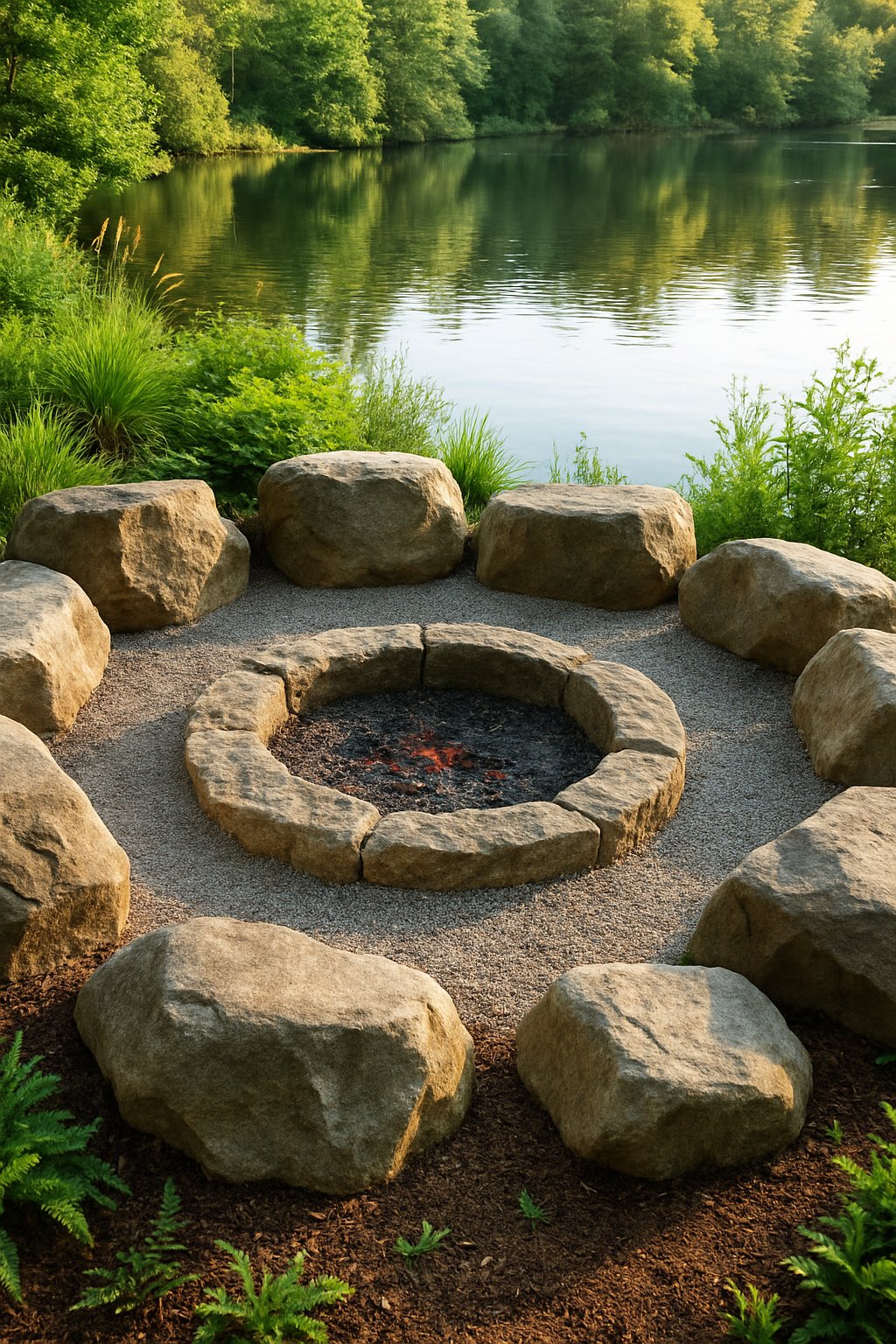
Build a gravel fire pit to make a clean, natural space by your lake. Place large boulders around it for rustic seating that fits right in with the landscape.
The gravel drains water well and keeps things tidy. Arrange the boulders in a circle to create a comfy spot to sit.
Mix up the size and height of the boulders for a more natural look. Pick heat-resistant stones to stay safe around the fire.
Bury part of each boulder to keep them steady and help them look like they belong there. You’ll have a cozy place to gather on cool nights by the water.
This setup needs hardly any upkeep and just fits with the natural lake vibe. Add some soft lights nearby to make it feel welcoming after sunset.
Expert Tip from MrPlanter: “Make sure to place the fire pit on level ground and keep a clear space around it for safety. Use natural stones that can withstand heat to avoid cracks or damage.”
24. Add a natural shoreline buffer with ferns and sedges
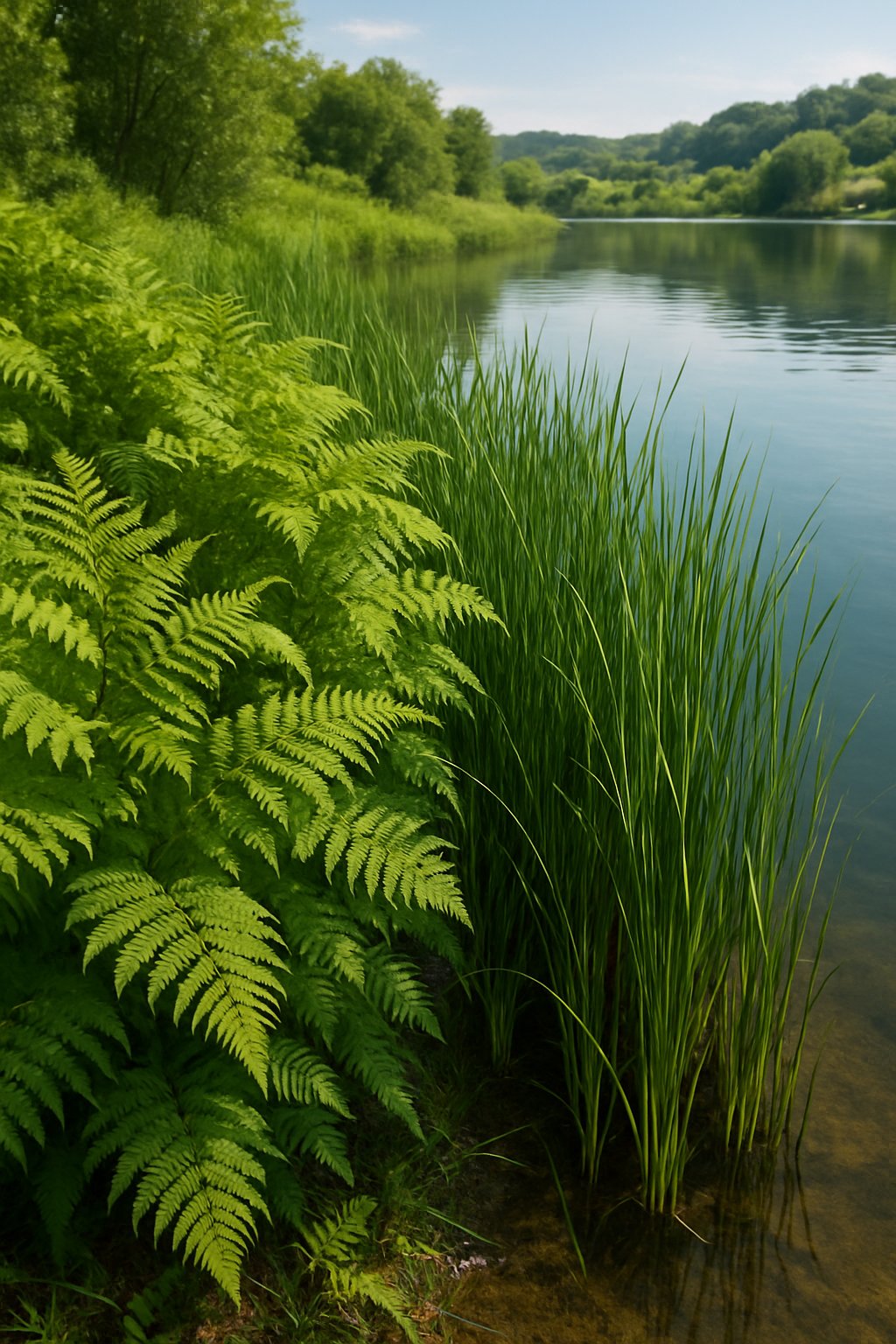
Plant ferns and sedges along your shoreline to build a natural buffer zone. These plants hold the soil in place with their roots and stop erosion.
They also slow rainwater runoff, which keeps your lake water cleaner. Ferns and sedges make great homes for birds and insects.
Native sedges—like tussock sedge or lake sedge—love wet spots by the water. Ferns bring in fresh green color and texture, making the shore look lively.
You don’t need to mow right up to the lake. Leave at least 10 to 20 feet of this buffer for the best effect.
This zone filters out pollutants before they reach the water. It’s a simple but powerful way to protect your lake.
Expert Tip from MrPlanter: “Start planting small patches of sedges and ferns. Over time, they will spread and cover more area naturally.”
25. Use floating solar lights on the water
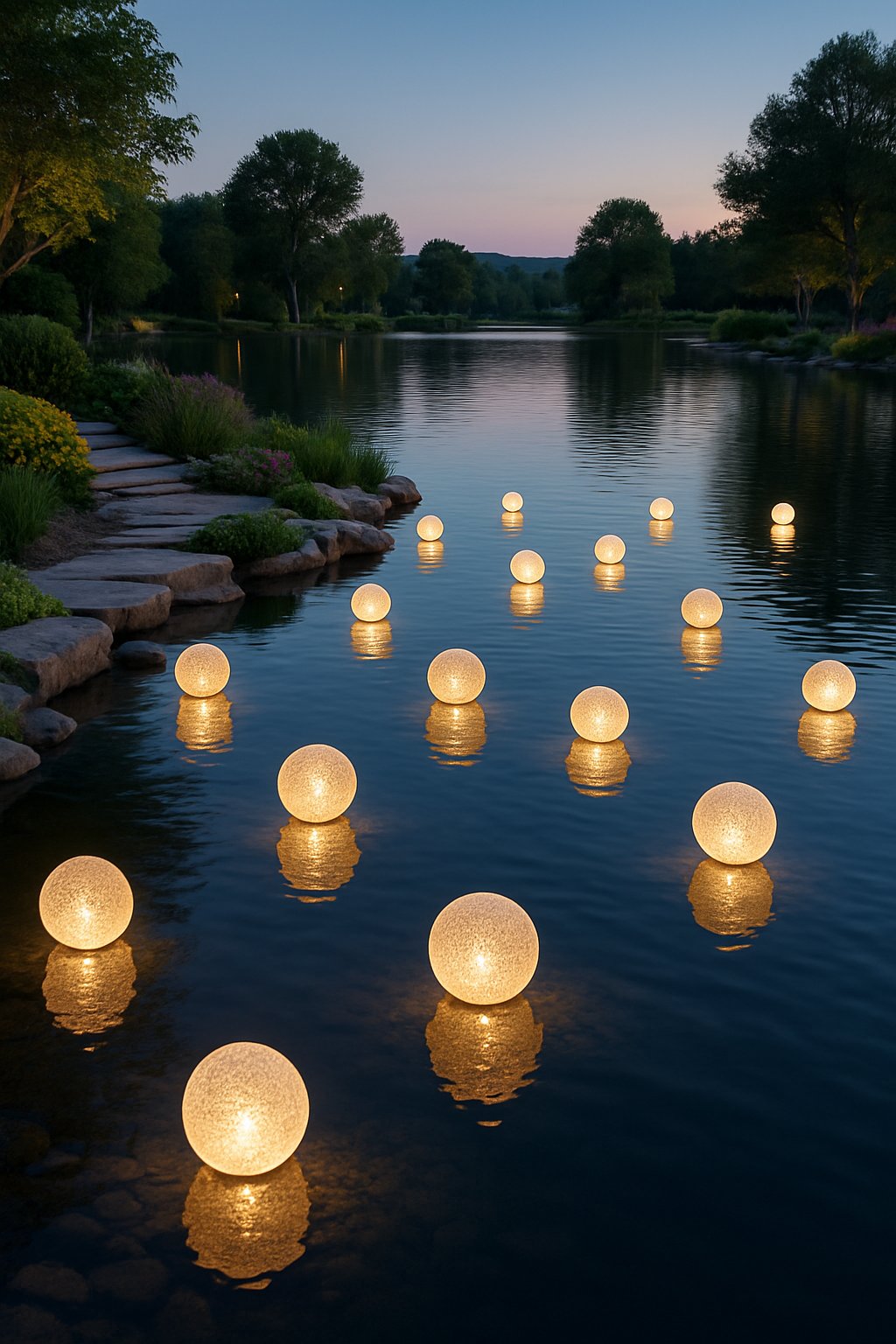
Toss a few floating solar lights on your lake for a gentle glow at night. They give the water a peaceful, almost magical look that’s perfect for evenings.
You don’t need to mess with wires—these lights charge in the sun and float around after dark. It’s a breeze.
Pick from lots of styles and colors to fit your taste. Some even change colors or flicker for a little extra flair.
Floating solar lights are energy-efficient and easy to move wherever you want. They work best in calm spots near the shore or tucked into coves.
Put them where they’ll soak up the most sun during the day. Try to avoid placing them in areas with strong currents or big waves.
They brighten up the lake and add a magical feeling that’s great for relaxing or hosting friends.
Expert Tip from MrPlanter: “Choose solar lights with waterproof and durable materials to last through the seasons. Group several lights for a stronger visual impact on your water.”
26. Plant fragrant herbs near outdoor seating
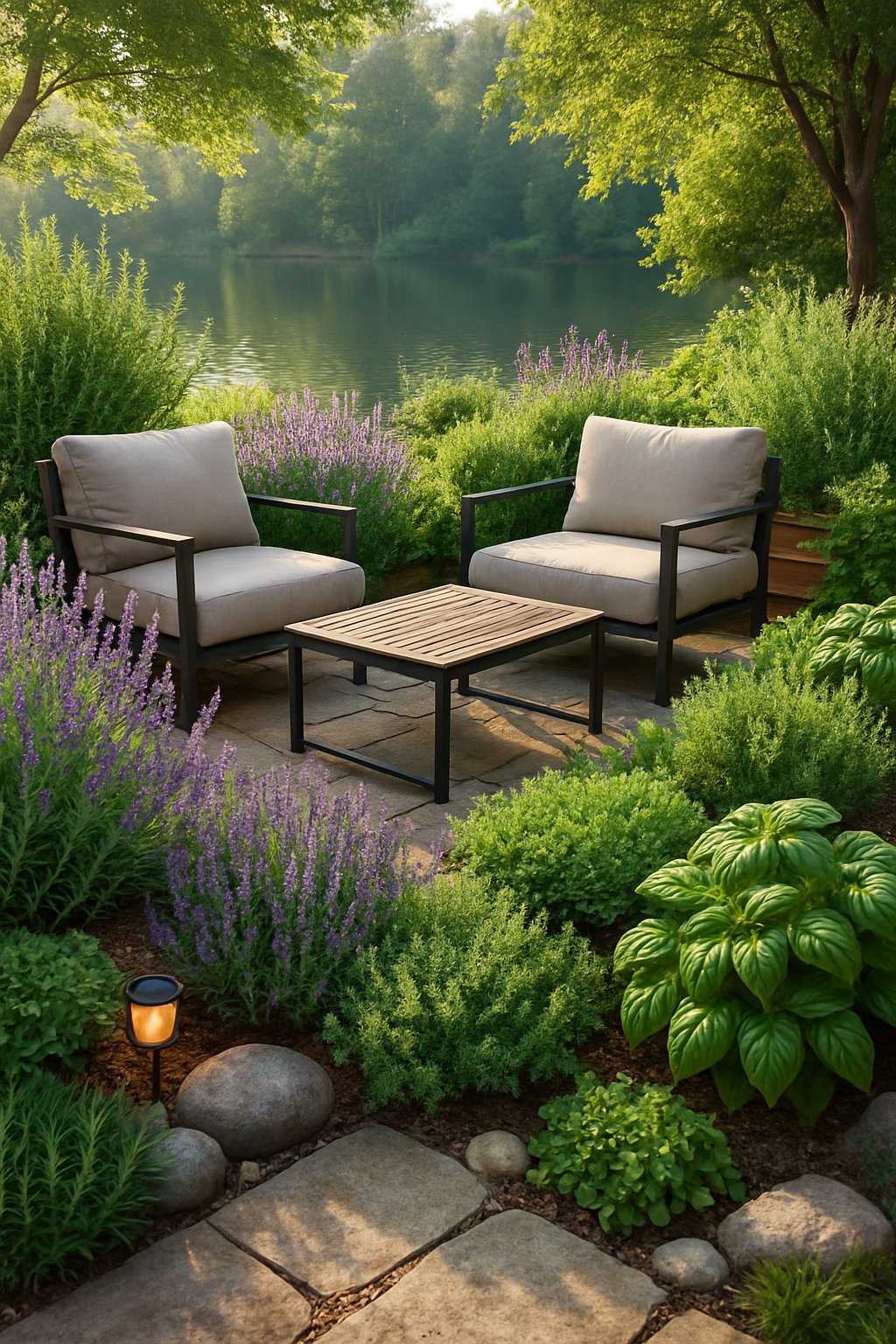
Try planting fragrant herbs near your outdoor seating for a fresh, relaxing scent. Herbs like mint, lavender, basil, and thyme fill the air with aroma while you’re outside.
Their scent keeps bugs away, too, so your seating area feels more comfortable. These herbs are pretty easy to grow and don’t need a lot of fuss.
Put them in pots or garden beds close to your benches or tables. They’ll add a splash of green and some color as well.
Planting herbs nearby means you can snip fresh leaves or flowers for cooking or drinks. It’s a fun way to connect your garden with your daily routine.
Pick herbs that suit your climate and soil for the best results. Mixing a few types keeps the scent fresh all day.
Expert Tip from MrPlanter: “Place herbs on the sunny side of your seating area for stronger scents. Regularly trim herbs to encourage healthy growth and more fragrance.”
27. Build raised garden beds with lake-friendly plants
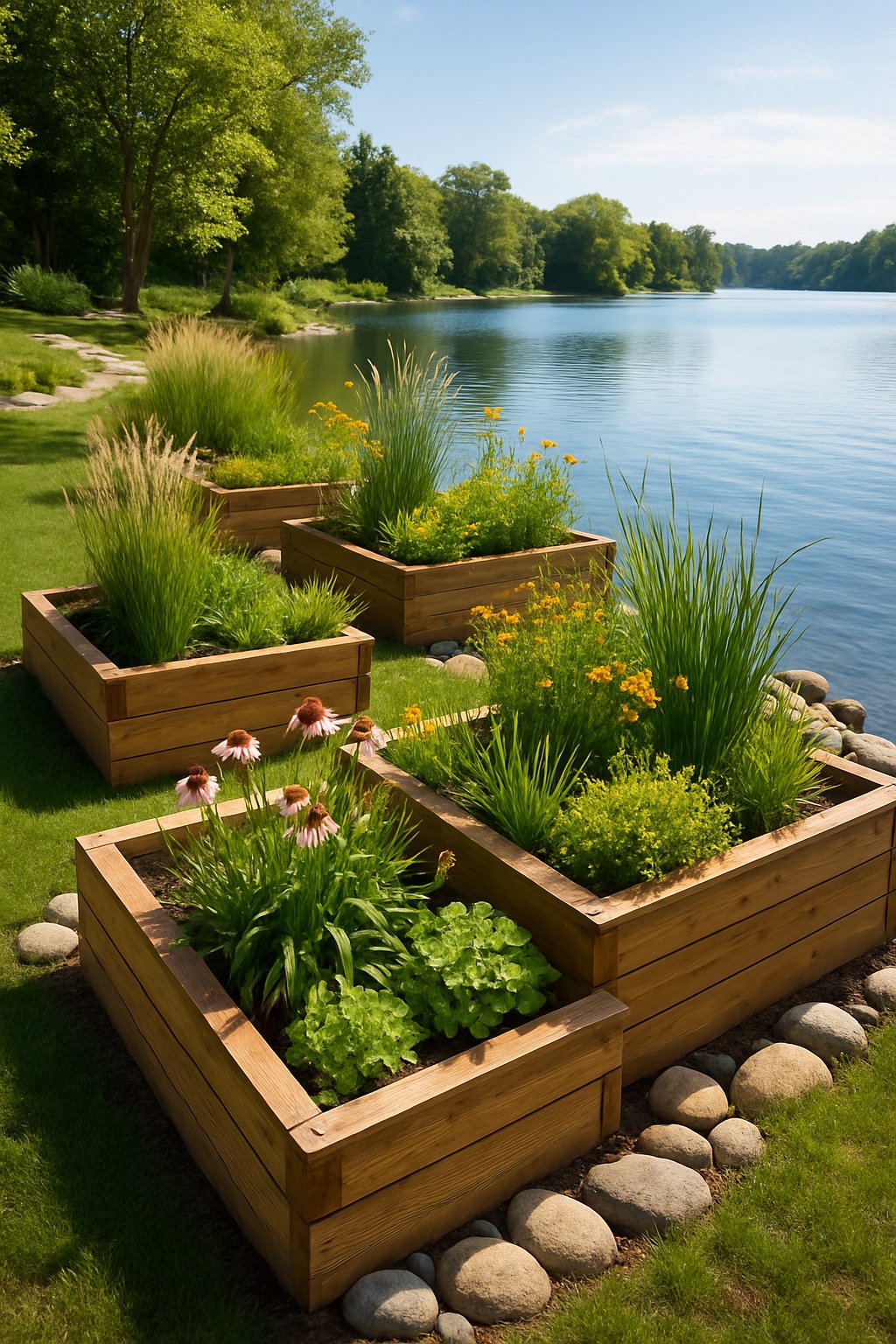
Raised garden beds add structure and a bit of charm to your lakefront. You get to control soil quality and drainage without much fuss.
Pick plants that can handle moist soil and won’t mess up the lake water. I usually go for native species like sedges, pickerelweed, or blue flag iris—they just seem to thrive.
Stick with natural, untreated wood or stone when building your beds. That way, you keep chemicals out of the lake.
Find a sunny spot for your beds—plants need their light, after all.
Raised beds help stop soil from washing away near the water’s edge. You’ll keep your lake view open and the plants happy.
Try growing flowers, herbs, or veggies, but make sure they’re safe for your lake’s ecosystem. Smaller beds are easier to care for, so don’t overdo it.
Expert Tip from MrPlanter: “Pick plants that help filter water runoff before it reaches the lake. Raised beds with native species make maintenance simple and eco-friendly.”

